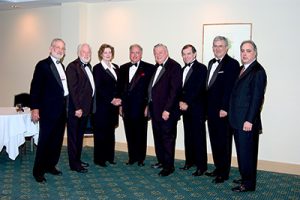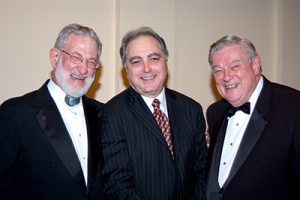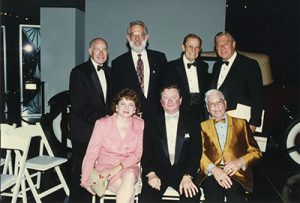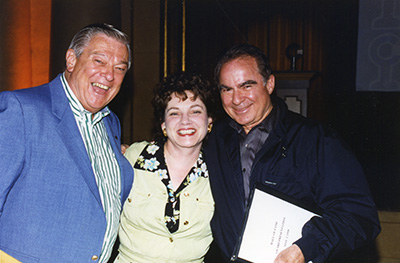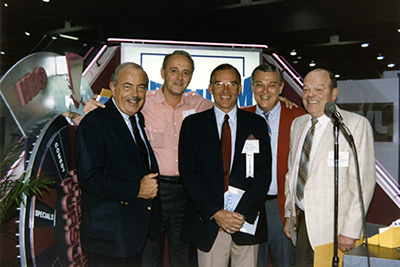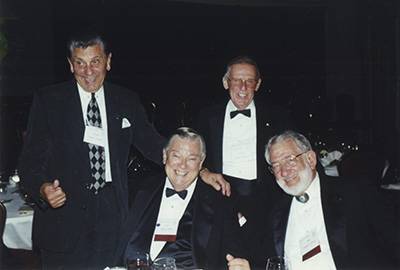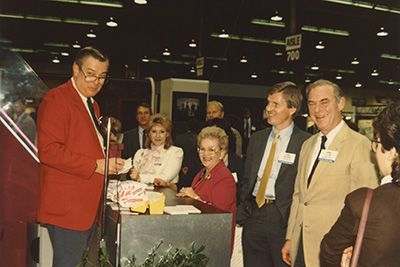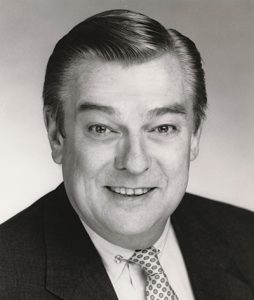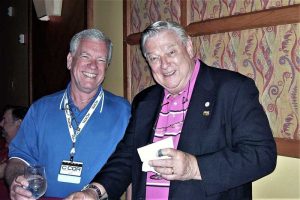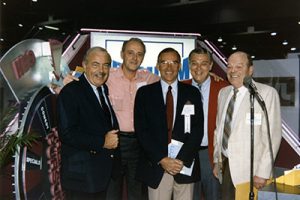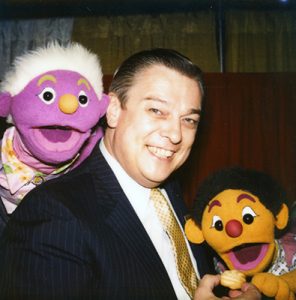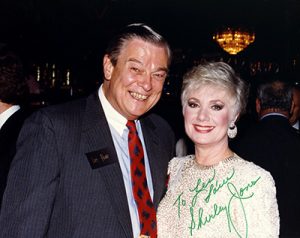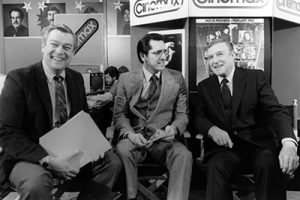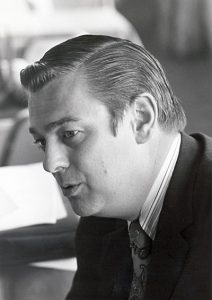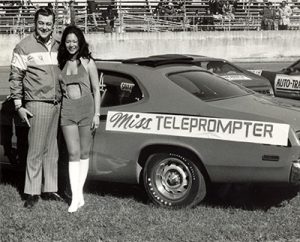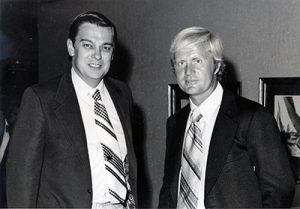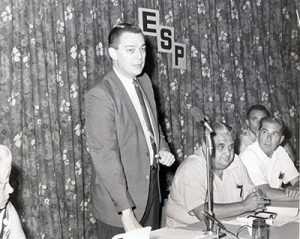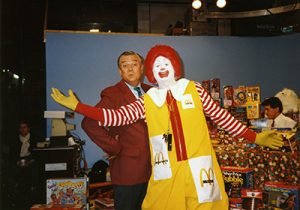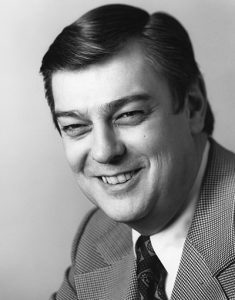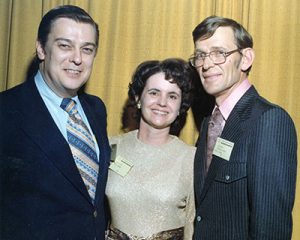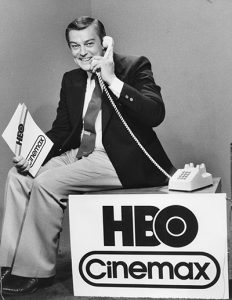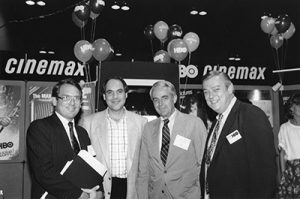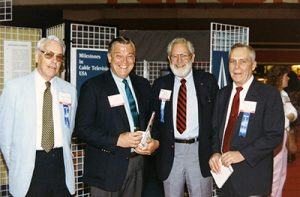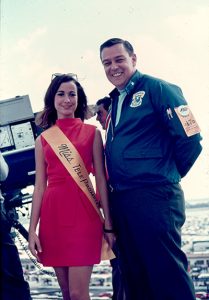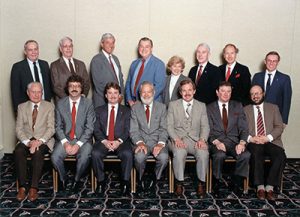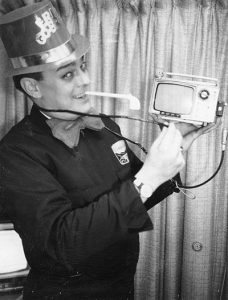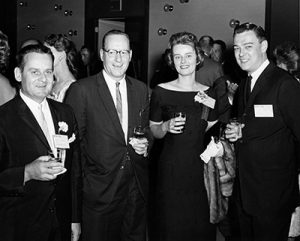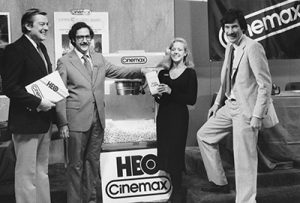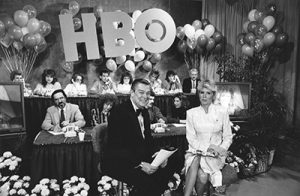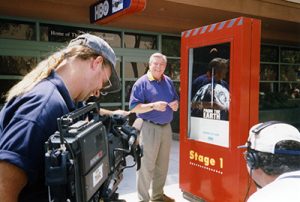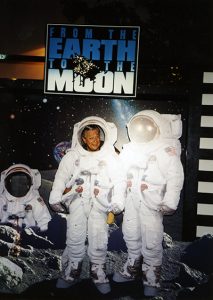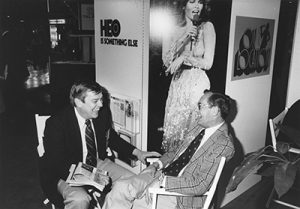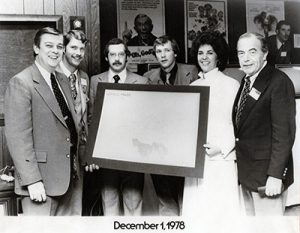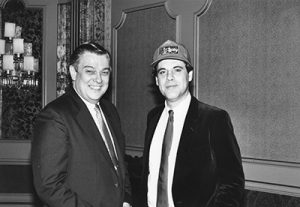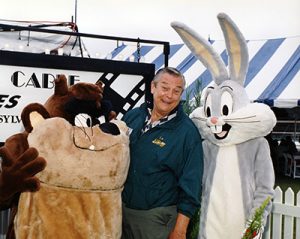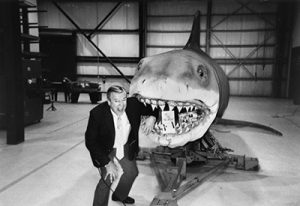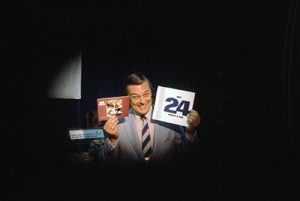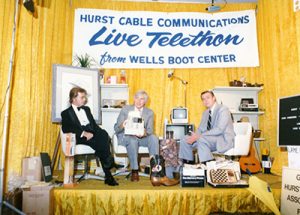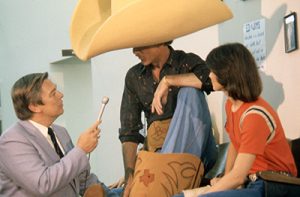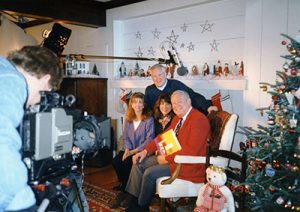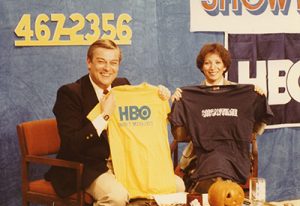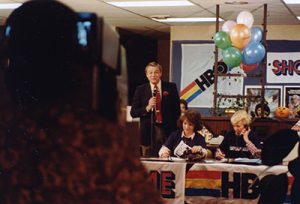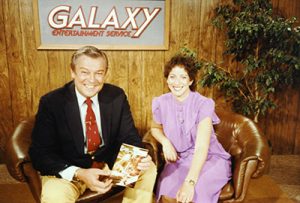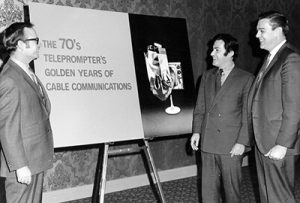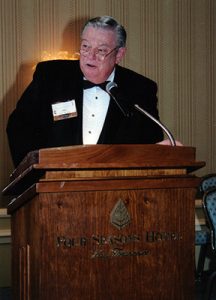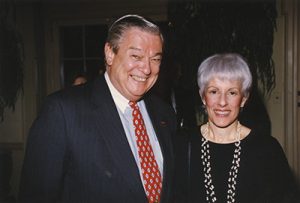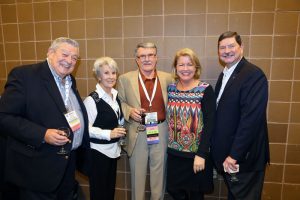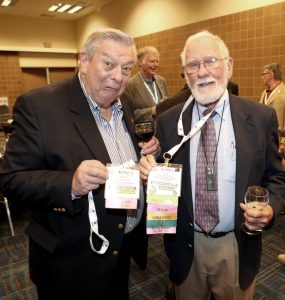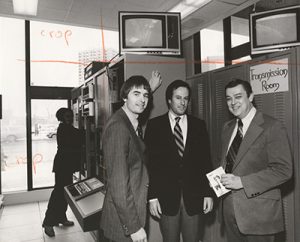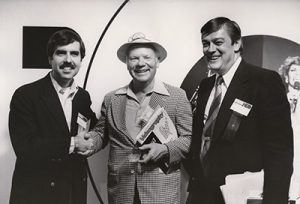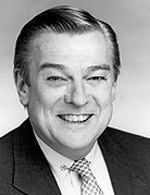In Memoriam
1935 – 2018
See bottom of page for full memoriam.
Interview Date: Wednesday June 20, 1990
Interview Location: New York, NY
Interviewer: E. Stratford Smith
Collection: Penn State Collection
Note: Audio Only
SMITH: This is Tape 1, Side A of the oral history interview of Les Read of Home Box Office. Les, what is your official title?
READ: Director of Special Projects and Promotions at HBO. I am in the Marketing Department.
SMITH: We are in Mr. Read’s office in the HBO Building at 1100 6th Avenue, New York City. Today is the 20th of June, 1990. This is one of a series of oral histories of pioneers and leaders in the cable television industry that is being done under the auspices of the National Cable Television Center and Museum at Penn State University. Les, the usual procedure is to start at the beginning. We might as well do it that way. Would you tell us when and where you were born?
READ: We should mention that Dick Tracy just opened in the movie houses, so if anybody really listens to this they’ll realize at what point in time we are. In the beginning, September 12, 1935. I was born in Long Island in a hospital in Mineola, New York. My parents were both kind of new to this country. They both came from England. They were living in a town called Great Neck. My dad had been in a service station operation. He had started with Henry Ford way back when he (Dad) first came off the ship. He was running service stations in Great Neck, Long Island, New York, as we refer to it. I grew up and went through the local public school system and from there, Great Neck High School. I graduated from high school in ’53. I was a heavy duty, arts-area, hands-on person because I was great at print shop, and auto mechanics I and II, because my dad had service stations. I wasn’t quite sure where I was going to school, at that point, but I knew I better do something. As life goes on you have to compete with people. I felt it was important to get a good, solid, basic business background. I went out on my own, unbeknownst to my family and got enrolled at a junior college in Dudley, Massachusetts. In those days it was Nichols Junior College. It is now a four-year school, and it is also coed. It was an all boy school then. It always felt to me when I first got there like a school for wayward boys. We had our opportunity to get that firm foundation of business. That’s what I was really there for. I learned how to become a pretty decent student while I was there.
Based on that basic training, I transferred to Syracuse University in 1955. I was in business for a year and then transferred to the school of speech because they had the major in radio and television, which was my interest at that point. In the back of my head I still, to this day, have a great romance for radio. I’ve always felt I should be on the other side of that mike talking to people in radio. I did the rest of my degree requirements at Syracuse and graduated from there in January of 1958.
SMITH: What was your degree when you graduated?
READ: In those days we called them BS degrees. Bachelor of Science.
SMITH: That was it.
READ: That was my educational background.
SMITH: Les, we jumped a little bit. You said both of your parents were of English background.
READ: They both came over about the end of the ’20s, I guess it was.
SMITH: Were they married at the time they came over?
READ: No, they got married here.
SMITH: Did they meet here?
READ: They had met very briefly over in Liverpool where my dad was from. Then they met each other again over here.
SMITH: Was the meeting over here a planned one as a result of the first meeting?
READ: No, actually, it was through another friend that said, do you remember meeting Charlie, etc. They were kind of brought back together with another three couples that were living out in Long Island at the time.
SMITH: You say your father was in the service station business. Gasoline service station type with Henry Ford.
READ: Well, actually that was his first job with the Ford garage in Great Neck. He had met the whole Ford family back in those days. Those were the days of the Model “A”. That was one of the first cars I learned how to drive. It was based on that experience and his ability to manage people that he felt that it would be a good area to get into in the service station business. He was one of the first operators in Great Neck, Long Island. As a result, he did thirty-three years with the Gulf Oil Corporation running a couple of service stations in the Great Neck area.
SMITH: Is your father still living?
READ: No. My dad and my mother both passed on.
SMITH: Les, do you have any brothers and sisters?
READ: I have a sister, who I am always pleased to say is my older sister. It bugs her a little bit. She’s three years older than I am. Throughout the course of my career in cable, I have ended up living today, about six miles from my home. Or just about a mile across the bay, actually. I am in a town called Port Washington, which is my present residence. But my sister has also ended up in the next town from there. So we have always stayed close as a family. She is married to a gentleman by the name of John Saunders, who has quite a career in construction. He has run one of the largest construction companies in the greater New York area. They have two children, a daughter and a son.
In my own family situation today, as we go through the travels down the cable highway, my wife is from Great Falls, Montana. I met her when I was on an assignment down there building a cable company. We have four children, which as of today’s date is 1990. The youngest is a ninth grader and fourteen years old.
SMITH: Would you give us their names?
READ: That’s Jennifer. My youngest son, Charlie, is fifteen years old, and doing about everything wrong as a fifteen-year old would do right now, I guess. I’m sweating out final exams with Charlie. Then I have another daughter, Elizabeth Ann, who is twenty-one. Scott Howard, number one son, just graduated from Syracuse University with an international degree. With an international degree, he is headed to Boulder, Colorado, according to him, to find himself.
SMITH: That figures.
READ: I said whenever he’s ready for a reality check, he’d better leave in a hurry. It’s funny, because in a brief number of conversations that we’ve had–he’s been out there now about a month–he is getting used to not having to go to school but he’s starting to ask some questions about the cable industry and who do I know out there. He’s thinking about getting legitimate and finding a job.
SMITH: I’m sure he’ll do that too.
READ: I hope so. But he’s on his own nickel so I don’t worry.
SMITH: Les, let’s go back to your boyhood for just a moment. When you were growing up, did you have any special interests and hobbies?
READ: As I remember growing up, there were a couple of areas. Sports-wise, I loved to ice skate and swim. I ended up doing both of those things to make money going through high school and college. I was a lifeguard for five summers and I was a skating instructor at a rink in Great Neck where I was raised. In terms of high school sports I participated in everything. I played one short season as a football player. My dad seemed to think that if I was healthy enough to go out there and get banged around I should be healthy enough to come down and give him a hand at the service station. There was more encouragement to go to work at that point. I worked quite a bit at my dad’s station. One of the key things I have learned over the years was the service business and dealing with customers–even when they come in for silly little things like gasoline–which today is dramatically changed from what it used to be. You pulled into my dad’s station and you knew the customer’s name and you greeted them. You didn’t ask them if you should check the oil. You checked the oil. You checked the tire pressure. You provided service. Those people kept coming back. That’s why dad was so successful in the area where we are. We are about twenty-two miles out of the city. You had a husband working in the city, a spouse with a car, children with cars; he had service when they would call and say, “Charlie, pick up the car and take care of it.”
SMITH: He’d sell you a gallon of gas for twenty-five cents.
READ: Yes. And you had to have your A coupon, too, if you remember those. That was, as I have always felt, over the years, even in my job today dealing with special projects and trying to get the cable operator to do a better job of promoting number one, his own cable service along with HBO services. You have to think about that guy, the viewer, and how does he react and how does he think. It’s not a lot different than that person who used to come in and they weren’t stunned when you had a rag in your hand and you would wipe off their headlight. They came back. They liked the service. He sold a lot of gas. I mean it was a couple of thousand gallons a day in this particular location. So, it wasn’t a small operation.
You had another question, too, about my boyhood. One of the things I was fascinated with was sound. In my day it was called hi-fi. That became a nickname of mine because you’d walk into my room and I’d have sixteen or eighteen or twenty speakers, monaural, in those early days. I had to have a good sound system. I loved photography. I have always enjoyed capturing whatever the opportunities and the moments are to take pictures. As you can see with the memorabilia I have around the office here, I love to keep track of all the places I’ve been and the highlights and the opportunities of having worked with so many fine people we have in the cable industry. I think, really, at this point–I think it’s thirty one, thirty-two years–I have been involved, or as you so lovingly say, “You’ve been around forever.” I’ve had a great rocket ride, as we say, in life and the cable industry. So I’ve got a lot of the photos and I like taking photos. I’m almost as bad as Burt Harris.
SMITH: You and Burt would make a good team. Les, how about military service?
READ: Yes. I had a very dear friend. I was a junior in high school and he was a senior. The Air Force Reserves had a recruiting program going on and if this fellow brought in a recruit he won a free trip to Miami, Florida on an air transport plane. In those days they were called C-119 cargo carriers. I was it. I was the recruit that he brought in. I got him to Miami.
I joined the Air Force Reserves when I was a junior in high school and went faithfully once a month. We had our weekend meetings and I got involved, interestingly enough, in communications. It was my first assignment. I later went on to get into air traffic control and, as we said, “sat in the hot seat” and dispatched, took flight plans, and all that information. I enjoyed that very much. But I did all of my eight years in the Air Force Reserves. It was all through the reserve program and when it came time–I had just graduated from college–and I had been back out for a meeting and suddenly I had a draft notice. You know, “greetings from the president.” I said, “Gee, after all this time I get drafted.” Well, every officer in the organization was ready to kiss me off and said good luck. Hope you enjoy the Army, after all my years in the Air Force. There was one well-fed recruiting sergeant sitting in the corner who said, “Hey, junior, what’s your problem?” How happy could you be if you had one of these announcements, which is the greetings from the president. He just casually looked up and said, “They can’t touch you.” This was old Sergeant Gottfreid. I sent him half a case of scotch because he was right. Because of my time and number of years of service, there was a presidential order that said, no he can’t be drafted as long as he continues to serve. Which I did. I didn’t do active duty, per se, but I did my monthly and two-week encampments throughout the summer. I was quite proud of that time, and again, it was another great experience where I learned how to deal with people and get on with people of all different levels of educational and economic background. Damn good experience.
SMITH: You indicated a moment ago that you have a love for radio. Did you actually ever get on that mike and operate a radio station?
READ: Never really quite radio. After I graduated from Syracuse University–it was January of ’58–I said, “Gee, here I am in Syracuse.” I knew you couldn’t really break into the media in New York City. You’ve got to go out to the boondocks and sweep the floors, clean the windows, call on people, answer phones, etc. I said, “Gee, maybe while I’m here I should go to this radio station and just see if they have an opening.” It’s quite funny today because I’m so close with the Newhouse organization through their New Channels and Vision Cable. It was the Newhouse radio station in Syracuse. The head announcer was Floyd Ottoway, and he said, “Hello, you have a nice voice.” I said, “Thank you very much.” He said, “Here, read this.” He gave me a list of about thirty-seven to forty-three classical composers and he said, “Read it.” I said, “Read it, I don’t even listen to this. I don’t know these guys.” I knew I was just going to kill the names. That was my close brush with radio. I have, over the years, continued to do a lot of radio interviews whenever I get to communities and towns where I’m working with cable operators or special projects that I do with Home Box Office. I love to get into the radio station, whether it’s call-in shows or what, and do the radio thing. Radio still has a great deal of imagination to it.
SMITH: Les, let’s go back and talk a little more about your wife. So far all we really know about her is that you met her in Great Falls, Montana. Tell us a bit more about her; how you met.
READ: Her name is Ann Marie Erickson Svenska. Her family came from Minneapolis and moved to Great Falls, Montana. Her dad is a great outdoorsman; loves to fish and hunt. His world is to go sit in the boat and fish or go hiking through the hills. He didn’t like the restrictions; he’d been on a farm outside of Minneapolis. He decided that wasn’t the area for him and he put the family in a trailer and he moved to Great Falls, Montana. He was also a very talented carpenter. When he got to Great Falls, in those days it was a very tough union state, he balked at that. He ended up going to work for the school system as a carpenter and did his whole career in custodial services rebuilding door frames and cabinets and doing his carpentry work for the school system.
Ann went to schools in Great Falls. Her two interests in life were nursing–she did a candy striper job at one of the hospitals in Great Falls–and she was blessed with a magnificent voice. She decided to expand and grow and she did quite a bit with voice lessons. She became one of the key singers around Great Falls, where she was always getting asked to sing at somebody’s wedding, at funerals, or whatever the event that might be going on in a community such as Great Falls. She was kind of following a career in classical music. She was looking at the Northwest Metropolitan tryouts and she was on that course. She had gone to the University of Montana in Missoula. She had first gone to a school in Nevada, Missouri–Caudy College. It’s a school run by PEO’s, which is a very special organization.
SMITH: What does PEO stand for?
READ: I don’t really know. It’s better than a sorority, I guess. But it’s all for development and growth in the educational field. She was fortunate to have some assistance in a scholarship program to go to Caudy College. She finished there and then went to the University of Montana in Missoula and graduated with a degree in education. She became a music teacher in the Great Falls school system. In those days, it was a traveling job where she had twenty different elementary schools. Each school didn’t have a music teacher so she was the rotating teacher. She would go in and teach some courses.
To make a long story short, she has since gone back recently–two, three years ago–and gotten a master’s degree in music education and is working in a community next door to ours in Long Island. She is developing new music programs for handicapped children. Music is still a marvelous, magical way to reach kids with great problems, great learning disabilities. When they can’t think through problems, you can reach them through music. She has developed a number of programs and is also still doing a couple of different schools, so she does her traveling routine. She is still involved musically. She is one of the lead sopranos with the church choir, she is with a Queens Choral Society, which is a fine, outstanding choir that operates out of Queens College.
She has gotten very involved with the head of the music department at Queens College and she works there on a Saturday project for an advanced program. If you’re at all familiar with the Suzuki method, at two years old they give you a fiddle and say just go ahead and fiddle and by the time they’re six or seven they start sounding pretty good. It’s the same type thing with voice that they’ve been doing. She has developed this program with a professor. It’s quite an advanced program in music and she’s one of the instructors and teachers there. So she is quite dedicated to music, along with trying to keep track of a fourteen year old and a fifteen year old. I guess it must be like flying a P-36 and you take a few shots off the wing and it starts going down. Our daughter has just decided she is not going to take any more piano lessons at the age of fourteen. No more piano. So the mother is a little broken hearted at this point. But my daughter plays a pretty good piano.
I think that’s about complete on Ann. She came from Great Falls. It was kind of funny because my dear, sweet, little old English mother, who was 4’11”, used to always say, “Son, you’re going to meet the nice girls at church.” Needless to say, I met Ann with a couple of other gals who had gone to a movie and had gone in to have a beer at Duffy’s Tavern in Great Falls, Montana. So when I called home and said, “I have this new girlfriend”, my mom said, “Where did you meet her?” I said, “St. Duffy’s, mom, St. Duffy’s.” Eventually, a year later when we got married, both my mother and dad came out for the wedding and the first thing I had to do was show mom St. Duffy’s. We didn’t have a chance to go in and have a beer with mom but she got a real rip out of that one.
SMITH: You describe your wife’s interest in music and the uses to which music can be put to get to problem students, children who are not otherwise easy to communicate with. Has she done any publishing in that field?
READ: No. No publishing. She designed the course material but nothing has been published at this point.
SMITH: Let’s just take one step back to your own college activities. Did you have any special interests while you were in college other than just studying and getting your degree and getting out?
READ: Let me jump back to Nichols College where, as I meant to say, I was really an industrial arts major in high school. And here I am trying to get a basic business foundation and also having to learn how to study. My first semester I did everything I could just to hang on to make sure I was there for the next semester. Nichols had this very small campus and I got to know an accounting professor, Max Cantum and his wife Katherine, who kind of took me under their wings and said, “If you’re going to survive here’s what you need to do.” It was through the sessions when I would go over to their house in the evening and sit and talk, get involved with the academia that was all around me, I suddenly caught on to how to study and how to get it done.
At that point, I became very involved with campus life and took on a couple of special social committee assignments because I loved to make arrangements and make things happen. Eventually, I became the social chairman, planning three major functions on campus. It was a funny campus. We were close enough to New York that in three and a half hours you could drive down to New York and go to Boston in another direction in an hour and twenty minutes. You were close to the coastline. Not a lot of people hung around the campus all weekend long. We did carry on a very extensive social program to keep people involved. So based on that, I got quite involved in that and that led me into the Green Coat organization, the Justinian Council. This was the student government, which I had the honor to serve for a year and a half. That was pretty much a full time job.
I also, at that point, was still involved with photography. I had a lot of equipment that I kind of stumbled into. Those were the old days of speed graphics cameras and the press camera. I did a lot of photography for the newspaper and for the yearbook. Going over to Syracuse, from a campus where there were three hundred people to a campus where there were twenty-five thousand people, was a real shock. Again, I had to relearn the whole system where you would sit in a classroom with maybe four or five hundred people sitting and listening to a lecture trying to stay awake and then trying to figure out how to answer the questions on test day. That was a new involvement.
I had a friend there, and I was introduced to SAE (National Fraternity of Sigma Alpha Epsilon) and it was that involvement that really took up most of my days on campus at Syracuse. I became very involved with the fraternity, serving in a number of positions, and ending up being Treasurer, which was a delightful job trying to collect money, particularly when you knew the guy was spending his room and board money down at the local pub. But, we did a pretty good job there. Again, being a transfer student I didn’t quite have all of the, as I used to lovingly say, “orange blood” in the system. At Syracuse, everything is orange. Therefore, I put most of my energy towards the SAE house of which, again, I was quite proud. Also, I got involved after I graduated from Syracuse working in a regional capacity. It was my first trip to State College. I had worked with the local chapter throughout Pennsylvania and New York state as an alumni working with the actives.
SMITH: The interviewer shouldn’t interrupt and put words on the record, but I just have to say this. I was also a fraternity treasurer while I was in college and I experienced much of what you were talking about. I was a Kappa Sigma at the University of Utah.
READ: We won’t hold that against you. But you do know. You had to follow people into the john as soon as their car came around the corner. You had to pay the bills and you were sitting there waiting and finally, for a couple of them, I just said, “Hey, I’m going to talk to mom and dad and see if we can’t help you out of a problem.” I made some great friends with parents. They’d send me the check direct.
SMITH: Well, Les, as we have to in these interviews we’ve got to get to the subject of CATV and cable. What was your first employment out of college? You might just start with that and then move on up to your first exposure to the cable television industry.
READ: Coming from Syracuse–having gone through that experience of having to read a list of forty classical composers–because of my family being in the Long Island area, I ended up coming back down to New York. It was January – February of 1958. I went into the RCA Building–as it was called in those days–the home of NBC, and I thought if nothing else I could pick up a job during the season when tourism picks up in New York City in the spring. I walked in and said to the Personnel Department, “What is it I’m going to be, a page or a guide?” The lady looked at me and said, “You mean you don’t want to be the president?” I said, “Well, I’ll work up to that.” She was thrilled and said, “You can be anything you want to be.” So I said OK and I ended up going to work at NBC. This was one of those “entry-level” jobs that you read about when you see a “Who’s Who” of people in the media business, broadcasting, print–any field where they’ve started in New York as an NBC page or guide.
Being the size I am, I had a uniform of some size issued to me. In the breast inside pocket there’s a label and on that label were names of people who had worn that uniform. There was a guy by the name of Dave Garroway and there was another fellow who did the “Do Re Mi” quiz show; he’s been around a hundred years. One of the people who I’ve run into in recent trips and travels in my cable days has been Willard Scott, who is also an alumnus from the NBC page staff.
Not too many years ago they had a fiftieth anniversary of the page staff. It was quite interesting. It was the days when Grant Tinker was still there. It was incredible, the people who came back, when you look down the list of NBC pages and guides who were there.
I ended up working in the Guide Department. Again, the woman said I could probably have more fun being able to use my voice. I was put in charge of taking forty green people from Anywhere, USA–or for that matter, around the world–and walking them through some usually bare studios. You had to make it sound exciting for the two or three dollars they were charging for this tour.
One of the fun stops along the way was the sound effects show that you would put on and that’s where you were able to show your best work. I enjoyed that quite a bit. It wasn’t too long after that I was made the head of the tour group, which gave me the opportunity to work with a lot of folks at NBC and develop new displays. Back in those days, it was a spin on radio.
Of course, television was continuing to grow and grow. We had to handle the assignment of making television sound even more exciting, and show how good RCA color would be so that you really want to think about putting a color TV in your home. We worked on the new displays and brought in some people who had worked at NBC and changed a few things around. After that, they say you have had a year and a half in the Guest Relations Department, as it’s called at NBC. That gives you the opportunity to make enough contacts and figure out what field you want to go into. It was at that time that I also had an opportunity to get into ticket distribution, which was another leg of the guest relations operation. We handled all of the tickets for the Perry Como Show or the Jack Paar Show. There were a number of theatres around New York City where these TV shows would originate. Not all of them originated from the RCA Building. Being a new person in the city, this was an incredible position to be in with all those tickets. You make a lot of friends and meet a lot of people. It was an interesting area, this dealing with tourists.
SMITH: You were in a position, Les, where you personally could make tickets available to people that…
READ: Always had about five or ten tickets in the inside pocket.
SMITH: You must have been a popular man.
READ: Let’s say I did a lot of horse trading in those days. Of course, you had interest from people who would come in and ask how they could get to go see a regular Broadway show, or something like that. So you would have contacts where you could say go see someone. It was through one of these contacts that I met in those days, they were called unit managers. He was a very dynamic guy. He had worked on the Today show. In those days I guess it was Hugh Downs who was doing the Today show. We got into a conversation and I said, “I would really be interested in looking into a unit manager’s job.” This was the interface between the network and the show producer. A Goodson Todman would come in and say we want to put on this quiz show and we need this kind of camera and this kind of equipment. Well, it was the unit manager’s job to control costs and keep track of what was happening in terms of getting the show on the network.
It was through this contact, he called one day and said, “There’s a company that might be looking for a guy like you.” And he said call this number. This was thirty years ago. Judson 2-3800. I can always remember the number. As it turned out, that was TelePrompTer’s number. It was TelePrompTer, which Irving Kahn–the founder–along with Hub Schlafly and another part-time actor who couldn’t remember his lines and needed a device so he could remember his lines had started. Irving, Hub and this fellow started a company and they were looking for somebody to work as a scheduling operator. It was kind of in the area of a unit manager. It was a facilitator, it was making sure you had equipment at all the different studios around New York whether it was the Ed Sullivan Show or the Arthur Godfrey Show or the Gary Moore Show. Gary Moore was a very big show for us. Gary Moore was so blind, he couldn’t see the small print so they had to use special prompters, which were about the size of a suitcase, a little bit bigger than an under-the-seat type suitcase. Those words had to be magnified and blown up so he could read them. Everything he said came off a prompter. There was no ad lib.
As the years went by, you would see the talent become more relaxed, more at ease. Arthur Godfrey finally said, “I don’t need a prompter anymore.” In the early days, everything Arthur Godfrey said was on a prompter also.
But it was through this phone number that led to this job as an operations type person scheduling equipment, operators, network studios, advertising studios, special filming jobs, that I walked over there and met a gentleman by the name of Don Redel. Don is no longer with us. He later went on to end up working for HBO in film acquisition, program acquisition area. Don put me on pretty quick. It wasn’t a very complicated process in terms of interviewing. I did have a resume and he said, “But can you talk? Do you know how to get equipment from here to there?” I said, “Sure.” To make a long story short, I did that for two weeks and he said, “You know, I’m wasting you sitting here at a desk. Go out and sell the prompting service to different shows, different advertisers–get more accounts.”
SMITH: I need to interrupt you Les, because the tape is running out. I’ll turn it over and we’ll continue.
End Tape 1, Side A
READ: Where did we leave off?
SMITH: We are starting Side B of Tape 1 and you were mentioning the fact that the man who employed you, Redel at TelePrompTer, said he was wasting your time having you sit at a desk and told you to go out and sell TelePrompTers.
READ: We had these big sheets where you had to make sure there were enough prompters and that the scripts were delivered on time, and that the operator showed up. It was a hairy operational job. But in time, he said go out and talk to people. With that I started going to a few folks I had made contact with at NBC through my guide days, page days. It was very interesting and easy to get in over there, which helped quite a bit. As I have found throughout the industry, being in both broadcasting from those days and cable for the last thirty years, contacts are so important in this business. What goes around, comes around. People just don’t disappear.
The first really big break I had came when we landed an Olde London food account, which was jellies and cheese crackers. They wanted commercials for an afternoon show that was called “Who Do You Trust?” It was taped at the Little Theatre which is at 44th Street, right next door to Sardi’s. Of course the guys who did that show–they were brand new together–were Ed McMahon and Johnny Carson. My job was to make sure that the scripts were there in the studio. It was an account rep type of situation. That the operator was there, that the equipment worked. Because in those early days of prompting, there was always a lot of problems with equipment. God bless Hub Schlafly and his selsyn motor. It was always a problem keeping these two or three or seven prompters in sync so that it was saying the same word at the same time. Sync was always our problem. Death defying act when it came to prompting.
I got to work that show and did that for a long period of time. I got to know both Carson and McMahon pretty darn well because they would do a run through–they would do about five shows in an afternoon–where you would do a run through and tape the show, run through and tape the show. Between the run through and the tape and a few other times, I always had a little time to run into Sardi’s. In those days when they were really good drinkers, it was time for a little warm milk–yech!! Off we’d go. Well that was the other part of my job, to see that we had a cocktail when we had to have a cocktail. We’d get finished with the taping and these guys would tell stories. Both of them are great, great fans of W.C. Fields. They would be forever just telling stories, remember this story about the time…. and they’re doing this whole take-off on W.C. Fields. We spent a lot of time there and they also loved music. Dixieland was a big favorite.
In those days–this would be ’58–there were a number of clubs on 52nd Street in Manhattan. It was Music Alley. We would end up over there till the wee small hours. Fortunately, I was living in the city at that point so I could crawl home on my hands and knees to get back to face the next morning. It was one of the most fascinating times. As you look back on it, when you were going through it, a job was a job and you were having a good time. It was truly one of the highlights of my career in the early days of TelePrompTer.
SMITH: Would you describe in a just a little more detail the matter of this sync problem? Were several teleprompters in operation simultaneously at different locations in the studio?
READ: Exactly. Depending upon the number of cameras on the shoot, a complicated show like the Gary Moore Show, you would have up to four, five, six cameras. Which meant that the operator of the prompting device had a machine so that he would monitor where it was and he was always following the person who would be speaking. On top of each camera, which is another interesting phase of broadcast history, Irving Kahn had to go in and kind of win over the union camera people and all the union representatives so that we could put a prompter on the camera, which was unheard of in those early days. As only Irving could, he did. It became very much a fixture on the camera. The first couple times around it used to sit on a stand on kind of like a tripod stand and they’d have to wheel this around the studio so it would be right under the camera. Finally, Irving won over the unions to say it’s okay to have my machine on your camera. It was a very hairy problem. On a panel of prompting paper there was a little hole and that hole would go over a special strip–a metallic strip–and until all of the machines held at that same time, it would stop all the other prompters if one was going faster than another one. The paper would go up and it would hit that strip and then they would all supposedly–remember that word sync–run together.
Well, as we lovingly kid Hub Schlafly, it didn’t always quite hold so that one prompter was telling you one thing and another prompter was running a little bit further ahead. It was a tough battle. Of course today, I, in my own job at HBO, do a lot of on-camera work and from time to time get to use a prompter. It’s all done now by video. There’s a small TV camera mounted in front of the TV camera and you just read your script off that. But in those days you had paper with up to seven pieces of carbon and the typewriter would write out in 5/8″ type. One of the most dangerous places when you had pages and pages of script was when one of those typists who would be banging away on this electric typewriter and the key would break and it would send this missile flying across the script department. It was incredible. Those were interesting times.
I mentioned to you that Dave Garroway, who had gotten out of the Today show, was doing a number of specials. He was one of the guys who developed “speech view”, like when you see someone at a public speaking event looking into a piece of one-way glass. These are outrigger prompters so that the person can keep eye contact with the audience but he’s literally reading his speech off of this glass. This same piece of glass was designed to go over the lens of the camera so that you, as the person on camera, would be looking right into the lens but you’re seeing your speech. This was the speech view concept that TelePrompTer developed.
Garroway called me in this one day and said, “Your damn machine has got straight glass.” I mean it was a piece of glass that covered the front of the lens. He wanted us to bend this glass so that when you’re on the side of the camera, you’re able to see it from any angle. I’ll never forget the man saying, “Well you dummy, don’t you understand that glass is the most flexible thing?” I’m sitting there saying, “Oh yeah, try and see what happens when you bend it. It’ll break.” But he was always after TelePrompTer to come up with a revised, improved type of machine so that he could see that script from any angle in the studio. I did the prompting for about a year when Irving had a very large interest in big screen theatre television. We did fights. We did automobile races.
SMITH: You say you did them? Would you make that a little more clear?
READ: In terms of other services that TelePrompTer Corporation provided besides prompting, there was a very large staging operation involving a number of industrial type shows, whether it was just speakers or just musical productions, they were done by TelePrompTer staging people. This also developed into using projection television. GPL–General Precision Laboratory–was the name of one of the early projections. We always had, again, one of these things trying to make 1950 equipment look like it was in the ’90’s. It was tough. You had tough screens. When it was good it was very, very good. But if it had a little kink in it, it could be lousy. TelePrompTer was doing closed circuit fights. More and more companies were interested in making presentations that were available around the country that you could send out to people as opposed to bringing them all to New York or Los Angeles. You could do a meeting and deliver it via television to these different areas.
Irving recognized the fact that, in those days, the leading motel keeper was a chain called Holiday Inn. That was the major player on the market. Irving hired a gentleman by the name of Bill Sergeant, who had been a vice president at NBC. Sergeant had some kind of connection with this Holiday Inn chain and he put together a staging package where every Holiday Inn across the country was going to have a moving, portable, large-screen projection unit for slide presentations; front screen, rear screen. There was a very special projector that Hub Schlafly had designed. The Telepro 6000. It was special because it could take a screen and light it up in daylight and project information on the screen. You didn’t have to sit in a darkened room. All of this equipment came together as an audio-visual package for Holiday Inn. It also had built into it that, if the need arose, you could put in television. That’s the area that we were moving–more and more video.
It was through this Bill Sergeant that I had gotten involved in a conversation one day. He was asking me about some of the different shows that I had been involved with. He said, “You ought to know something about this thing called CATV.” I said, “What’s that?” He said, “We’ll know more about it pretty soon because we’re about to buy a system in Elmira, New York.” I said, “Where’s that?” I had gone to school in Syracuse and I, on a couple of occasions, had been known to wander down to the SAE house down at Cornell. They had pretty good parties there. I remember seeing the sign Elmira. Never been there. That all came back to me. Lo and behold–this was now into the ’60s–it was just at this time that Irving had decided that CATV was the area in which he wanted to expand and grow because of this closed circuit ability. He acquired systems in Liberal, Kansas; Farmington, New Mexico; Rawlings, Wyoming and this was, of course, miles and miles away from little old New York.
SMITH: Did he acquire the Elmira system?
READ: He acquired the Elmira system because it was “in his backyard” and he could show it off to people. He wanted people to see what CATV was all about. The system that he acquired–it was very, very interesting because there were a couple of firsts. Spencer Kennedy Labs, Boston, Massachusetts had designed a very special amplifier in those days. It was a broadband, twelve-channel amplifier.
SMITH: What roughly was “those days” in terms of year?
READ: This would have been 1956 or 1957. They had gotten involved with a local TV repairman in Elmira and put this brand new concept of amplifier in. Before, they were called strip amps where you have an amp for each channel. That was what you put in back in the very, very early Jerrold days. The local operator got into trouble and they acquired another fellow so then there were two local repairmen. They had sold the system to a company called the New York Water Board. The New York Water Board ran water companies in New York state. It was interesting because they, I guess, felt that this was like running a water system. Their attitude was they would not build an inch of cable down the street unless everybody took the service. As we know, cable even at this day when we’re forty years along, we still don’t have one hundred percent penetration. There are still a few folks out there who will admit that, “I don’t even own a television set.” There are still a few folks out there that don’t have cable.
Well, this was one thing that was absolutely mind boggling that they thought they could build a cable system like a water plant. That they’d run it down there and everybody would take it. So it was at that point where the system was acquired by TelePrompTer. Great local problems, great bad press. It was the end of ’60 when this came about, when the negotiations were on. I believe it was February of 1961 when I got a call from a gentleman by the name of Monroe Rifkin, who was the treasurer, at that time, of TelePrompTer Corporation. He later became the founder of ATC. Today, he is still in the business as Rifkin Associates. Monty said, “I understand you might be the guy I should take up to Elmira with me to look at this cable TV system.” This came about from a comment of Bill Sergeant in a meeting that, “You ought to take this guy up there with you.” So I said, “Sure how do we get there?” He said, “There’s a train.” Trains were still around but it was the Phoebe Snow train of the Erie-Lackawanna that left from Hoboken at midnight. We met and got on that train and we even had one of those pull-down beds. We each had a compartment. We chugged into Elmira at 8:00 in the morning.
The other thing that I’ve never forgotten was the twenty-six inches of snow on the ground. We had something that was brand new in those days called an attaché case–a nice leather box with a handle on it. As they used to lovingly say, that would keep the sandwiches flat and fresh. In those days, it wasn’t too uncool to wear a hat, even one of the better stetsons around. We stepped off the Phoebe Snow in Elmira, New York and looked around and had to call out for a cab because there weren’t any cabs waiting. We took a cab over to Elmira Video. The office was located on 156 Lake Street and it was part of an old piano store. The owner’s name was Claude Buckpitt, who was one of those gentlemen who had the starched collar.
We walked into this store. The pianos were on one side and over on the other side there was a counter with the old swinging gate. The one thing that you noted right away was that there were these very small black and white tiles all over the floor. And you said, “Gee whiz, I wonder what this was?” It was the old building that used to be the movie theatre in the early, early days of Elmira history. That was the old men’s room we were standing in which was part of the office now. I looked around and said, “What are we doing here?” We asked for the manager of the firm, Elmira Video, and these people looked at us and said, “He’s not here.” We said, “Do you expect him in?” They said, “We don’t know.” As we later found out, because we had to sit and wait a little bit, the manager had left two days before in the middle of the night and just kept on driving out of town.
We had to sit and wait for somebody from the bank to come over and tell these people that the company had been sold. Those people–there were three ladies in the front office at that particular time–had no inkling that this was going on. In we walked with our hats on and our attaché cases ready to enter into the world of cable TV. That was my introduction to CATV in Elmira, New York.
SMITH: And it had been sold to TelePrompTer?
READ: It had been sold to TelePrompTer, yes. That was my entry into cable. I was there for a couple of weeks to look this operation over. A year and a half later I was still there. I kind of got hooked on Elmira. I was the first manager there on-site. It was one of those learning experiences because you really had nobody to tell you how anything was done but you just kept asking a lot of questions. I did find that the local people had never been told anything and were just plain upset with cable. Cable was a dirty word to start chomping on somebody.
The thing I found was that no matter what you were going to say or do, you had to let them get it out of their system and go ahead and beat up on me, and then kind of say, gee, here’s a break. Now can I tell you what we’re going to do. It didn’t take too very long before we had a quick, fast program to do things like basically improve what we had, which wasn’t very good. The system had been neglected. There had been no money put into it. The SKL amplifiers had a row of twelve tubes. In half of the amplifiers the tubes weren’t working. In those days it was $1.50 a tube or whatever and they didn’t have any in stock.
SMITH: These were broadband amplifiers?
READ: Broadband amplifiers, yes.
SMITH: Five channel or three or…
READ: These were twelve. This was one of the very first twelve-channel systems that was in existence. Not working very well, a lot of problems. Again, it got to some very basic things like there was a continuous on-running program of retubing these amplifiers. You constantly had to be retubing. The other interesting thing was, in those days there were things called tube shields. It was a little metal casing that would slip down over the top of the tube. Of course, the technicians used to find this a pain in the butt to have to pull those things and put it back. They’d never put those caps back over the tubes so we had radiation problems. This was something you begin to realize, after a while.
At the same time we were trying to do that, we instituted a program of cleaning up the system. You have to start right at the headend of the beast. It was an interesting situation because the headend was located at the local UHF station. Elmira is a community that is nestled down behind the hills. It’s kind of like a dried up lake bottom. Surrounding–God bless those hills–and keeping the signal out of Binghamton, which was fifty-four miles to the east, and Syracuse which was about sixty-five miles to the north. You have the Pennsylvania border right there. The closest would be Wilkes-Barre – Scranton, which was again UHF stations that had trouble getting signals out. We had the headend actually located in Channel 18 WSYE, a spin-off of WSYR, which was Channel 3 in Syracuse. This was kind of a, oh yeah, we got coverage down there through the other little UHF…
SMITH: Translators?
READ: It was a step up from translators because they had a studio. They would originate one show a morning. They did the local cutaways during the Today Show, that kind of thing. The lady’s name was Near. She used to run an information show, What’s Going On In Elmira? It was very unique that here we are competing with this UHF station who hated our guts, and yet and we were in their transmitter site with our headend and our equipment. We also had a great amount of problems because of the radiation of the station’s signal. Their signal was so hot that you constantly had to be fighting that problem. The relationship went on.
Of course WSYR was owned by the Newhouse organization. They had been looking at cable TV. Their company in that area is called New Channels. They had expanded and started to grow in areas like Corning, New York.
SMITH: Could I interrupt just a minute Les and ask you how many channels were you actually delivering in Elmira when you went in to take over that operation?
READ: It was a twelve-channel system. I think we might have had about six or seven channels, which wasn’t very good. We had serious problems when we walked in there. It was also a very small area, in fact, it was two thousand homes that were being served. We weren’t sure where they all were. We had trouble trying to figure out where the accounts were or when they last paid. I mean, basic business problems like you can’t imagine. It was a nightmare. All these things came at the same time where you had to try to put the pieces together.
As I said, we started at the headend and started cleaning up the lines. We knew that we had to do something to show some growth in the area. In one of the early meetings or press conferences that we held, we said that we were going to start at the closest area to the headend and we were going to build that section. That was more out towards west Elmira, as I remember. We had all these problems going on at the same time. This was my comment to you before about the fact that people just wanted to kick you up the side of the head because no matter what you said or did, cable was no good and you were cable; and that is who they wanted to kick. It was that matter of letting them get it out of their system and sitting and listening to them. You had to listen to those people.
SMITH: You’re big enough that you didn’t need a bodyguard.
READ: That’s right. I got into some uncomfortable situations. One of the nice things while I was there in Elmira was that two doors down from the Elmira Video office there was a local bar and grill called Sykes. There were three brothers. Arthur, who was a boxer and once went in the ring against Joe Lewis. There was Bill, who stuttered a lot because he was nervous, with his other two brothers. He was kind of the manager. And there was Ferris Sykes. Ferris was a wrestler, a gargantuan wrestler. They ran this very colorful local bar and grill. In those days it was my McDonalds. I could walk in and grab a burger. There was a woman in there who was like having a mother away from home. She was always telling me that I had to try this today or try that. I would usually eat two meals a day in there at least. I had an apartment in town, but it was not equipped to cook at all.
SMITH: This was before you were married?
READ: This was well before I was married. The interesting thing was that I didn’t realize who all the players were that came into Sykes Grill. Elmira is in the county of Chemung and is the county seat. You had a county government going on and you had a city government. Down on the corner was the Town Hall where the Mayor and the City Manager were. I didn’t know who all the players were but they all came to Sykes too. It was after about three months I started to put names together with what I read in the paper. The only guy I had met, at that point, was the General Manager of New York Telephone Company, who had no time whatsoever for cable television. He just didn’t like us at all.
SMITH: Were you on his poles?
READ: We were on his poles. New York Tel and New York State Gas and Electric. You know well the history of pole attachments in the early days. One of my challenges in life was that after having taken this beating of being associated with cable, I had to prove I’m not a bad guy just because I’m with cable. Whenever you went to any community function, the General Manager of New York Tel was sitting at the head table. That was one of my goals and objectives in the early days to say, hey, there’s nothing wrong with cable and I’m going to be up at that head table. Eventually, I got there. I used to love to give him a little shot in the ribs to say you’re not the only guy in town.
We went through this period of learning who all the players were. We were constantly getting killed by the press. Every story would come out as a major happening of something screwing up. And yet, the press was always there saying don’t you want an ad. So it was a rather unique relationship. Again, I might add, that the whole paper staff, the reporters, Coe Hoover, the editor, they also ended up over at Sykes Grill. That was the place to be. That relationship continued to grow. I must say that after we got through all the horror stories that they had to play they started to turn around and say yeah, but cable is doing that or here’s… and they would carry some of our stories.
It was about three months into my existence there–I would commute back and forth on weekends wherever I could because in those days I had an apartment with a buddy of mine who I grew up with, at 38th Street and Park Avenue, not too far from here, which is a very nice neighborhood. It was the old silk stocking district, as it’s called in Manhattan. A beautiful apartment, rent-controlled apartment. Even in those days it was $150.00 a month we were spending in rent for an apartment that had a front door and a back door and elevator service and a doorman and everything. Here I am in Elmira saying, “Gee, that’s the place to be.” In those days I always had a soft spot in my heart for hard-working women like stewardi, as I lovingly called them. We were in that area where the buses were running back and forth to La Guardia from the Eastside(Eastern?) Airlines terminal. We were always meeting dates. It was a great location all the way around. So I’m sitting there saying, “What am I doing here in Elmira when I should be down there in New York?”
I was always trying to schedule as many meetings as possible because New York is sitting there saying what’s going on up there, what’s going on. Irving had a constant stream of people coming up and going back and forth to Elmira because Elmira was only about an hours’ plane ride away. Of course in those days it was called Mohawk Airlines. When they flew, they were very, very good. Mohawk would bring people in and out of Elmira and Irving was constantly showcasing this system because, as I mentioned to you earlier, the other systems that he first got involved with were way out in Kansas and you couldn’t get to them too easy.
Irving, of course, was trying to introduce CATV to the financial world, to the stock analyst type people, so you were constantly getting visitors wanting to see what this thing was all about. Again, it wasn’t instant visitors because, as I mentioned, we had a lot of problems. You didn’t want to show all your dirty laundry. That whole tide eventually changed. We started to get a little better press coverage.
As I mentioned to you, we wanted to clean up that headend as quickly as possible, but we had to get new equipment to update and bring in state-of-the-art. As that new equipment came in we were always constantly out there trying to get that message across to the people in the community. As I mentioned way back there in the beginning of Side 1, in my days of pumping gas–perpetual gas–it taught me how to deal with those people. It was a service business that we’re in. To this day, thirty some years later, the number one problem that cable has got is service. Of course, it has continued to come back and bite us in the ankle and the nose and a lot of other locations because of the fact that we haven’t always done the very best job of listening to the subscriber, or answering that phone as quickly as we should, and yet what I find absolutely amazing is that not too many other industries are doing a very good job either. When I go to call a bank, I get music. When I go to call an airline to find out if a flight is coming in or to book a flight, I get music. I get put on hold. It’s just the fact that everybody is using communications so much more hectically and quickly that cable isn’t the only one in the world with these problems.
Elmira started to grow, subscriber wise, and we realized–again, if you take time to listen to Irving’s historical information, I’m sure you’d detect what a dynamic promoter this guy was because he told me the stories when he was first working Skouras in the theatre business where he would get more excited about the popcorn machine and have to sell Skouras on the fact that you’d make a lot more money out of that popcorn machine.
SMITH: He always was a visionary, wasn’t he.
READ: Absolutely right. It was through a lot of those things that we continued to get the message across. As I said to you before, after three – four months at this restaurant, Art Sykes turned around and just kind of started introducing me to the city fathers and say, “This kid’s doing a heck of a job up here.” It was kind of a blessing from Pope Art. Suddenly, you were part of the community. But boy, for that first three to four months, it was very, very lonely there. They would look at you with that New England yeah, you’re there but I don’t know if I like you or not. Yankeeism like you can’t imagine. I had to get through that period in Elmira, New York before the tide finally started to swing. But, I was accepted. Today, I think of Elmira as a second home. I have a number of second homes because my travels throughout the country in cable have given me the opportunity to meet a lot of townspeople, and things of that nature. That was the challenge, to get that x number of city leaders, city fathers, the powers-that-be in that community to say that maybe these guys are all right. They’re not here just to peddle some imaginary deal. It was after that, the numbers started to turn and we started to add some subscribers.
In talking about promotion, the biggest promotion that we did in those days, there was an antenna on so many roofs up there and the mast was sixty feet. The antennas were a couple of different type antennas. You had a UHF antenna and a VHF antenna because people were trying to pull these signals in. This gave us a great opportunity.
When we stop this tape because we’re going to change over, we’ll continue talking about some of the early promotions to get attention in Elmira. That was a fascinating period.
End Tape 1, Side B
SMITH: This is Tape 2, Side 1 of the oral history interview with Les Read in his offices at HBO in New York City. Les, you made some notes about where we should start when we reached the end of the last tape.
READ: We were talking of Elmira, New York having made some headway correcting all of the problems the system had when we took it over. We proceeded to get a bit of a turnaround of the local community feeling towards us and, at this point, started to introduce promotions merchandising to get people to react and either come into the office and place an order or pick up the phone and call in an order. The setting, of course, in the early days of cable was that you would charge $150 for the cable installation and the monthly charge for those seven or eight channels that we were delivering was costing about $3.50. We suddenly said that for $150 we wanted to have a broader appeal; if we could get more people on we could afford to reduce that price and introduce some installation-saving type of fees. I don’t recall being able to ever find any major promotions that had gone on by the other companies that had been involved there. So when we introduced these specials, these promotions and price reductions on the installation, it literally floored an amazing number of people. First off, the people who had paid their $150 to get the cable installed were calling wanting an instant rebate. Here we were back in the hole again trying to find our way out with the existing customers after we’d shown them all the improvement. We made a dramatic announcement in the fact that the installation price would now be $39.95 based on the reaction we got. Once that happened, things started to fall into place. That was a point that we worked from.
One of the most incredible responses that I have witnessed in terms of a promotion was what was called, in those days, an antenna trade-in. As I was mentioning to you on the earlier tape, in Elmira, because we were surrounded by all these hills, if you wanted to bring some signals into the home from Binghamton or Syracuse you really had to have an antenna mast that would reach up thirty, forty, fifty feet. Some people had some very elaborate guide wires on the roof to reach out and grab that signal. We did a number of promotions first introducing $39.95, which was very successful. People said, “Gee, that’s reasonable.” I believe that the early rate, at that point was about $3.50, although we did go to a $4.50 rate shortly after that. After we picked up all those $39.95, then we came up with this idea of an antenna trade-in where people literally just came to the office doors with these antennas hanging off the car, around the car. We had even agreed in the beginning to go up and take the antenna off the roof for a few people. That was until we got into some legal problems where we were threatened with being dragged off to court for ruining someone’s roof. They wanted a new roof job from the cable company. We quickly got out of that. We told them if they delivered the antenna we will give you the credit. We literally went from two thousand very unhappy subscribers–we were probably, more realistically at eighteen hundred–about a year later, we finished at approximately seven thousand five hundred. Not everyone was installed as quickly as we would have liked, but the demand was so great and we had to continue to do a PR program about what area was being wired next. We literally had people standing and waiting for things to happen when it came to cable.
This continued as a very positive growth and, at the same time, there was a whole new development of microwaving signals. We went on the hook for bringing in some New York channels and had agreed to bring in WPIX, WOR Channel 9, WNEW, which today is a Fox network, but was an independent station in those days. When that happened, that literally just mushroomed. This came in probably two years later on. I had gone on to another assignment, which we’ll talk about later, in Montana. This is what blew the growth of the Elmira system, the barn doors right off the place, when we got into these microwave signals. To that point we had improved on the existing signals we were bringing in over the air from surrounding areas such as Scranton, Pennsylvania and Wilkes-Barre, Pennsylvania. We had WBRE Channel 28, which is a David Baltimore station. These are names coming to me thirty-five years later. WNEP TV. We had Binghamton, New York channels. We, of course, brought in Syracuse.
I had left after maybe a year, year and a half. I was reassigned. I got one of those phone calls from Monty Rifkin and he said, “You’ve done such a terrific job.” And I’m saying, “Oh boy, here it is, I can get back to New York to my apartment on Park Avenue.” He said, “We’ve got real serious problems in Great Falls, Montana and we’d like you to go out there.” I was just literally stunned. Great Falls, Montana. I was kind of concerned about cowboys and Indians. That was a far piece out there. It was at a natural point in time when, where we had been and the projects we had going on, I felt comfortable in saying, “Well that’s something to look at. If this is what I have to do to get ahead, let me take a look.” At that, I made a trip out to Great Falls and, indeed, did find Indians.
SMITH: Before you get into Great Falls, Les, I want to interrupt you because at lunch with Irving Kahn you were telling a story that I think occurred at Elmira that I think would be very appropriate for this history.
READ: It’s appropriate in the fact that TelePrompTer Corporation was not afraid to try the new things that the industry continued to bring out. In a lot of cases it was Irving that was forcing them to; if you do this, this, and this, I’ll buy it. Well they’d run back to the drawing board and design and develop. That particular story that we’re talking about really belongs in the second time when I went back to Elmira. When I went back, there was a brand new cable that Times Wire had introduced that was called JT408. It was a brand new method of overlaying the copper braid–it was a very heavy copper shield–that was on this feeder line. In fact, it was so new they had forgotten that they didn’t have any connectors to fit that cable. We had suddenly received miles and miles and miles, and reels and reels and reels of this JT408 cable, which was going to eliminate an amplifier every quarter of a mile. This would really cut down the cost for the operator.
Great strides were being made. But we sat there with the cable in the warehouse yard waiting for Jerrold to deliver. We’d get two at a time. Some of the good days we’d get six connectors in a box for this JT408 cable. The cable got installed. The connectors, as we got them, were put on and suddenly the signal started to disappear. What had happened is that this copper braid started to be affected by the weather. Because of the effect copper has got we started to lose signal in this brand new, rebuilt plant that was the end-all to all the worries and problems that any cable operator could ever have. Fewer amplifiers, put it up and it’s going to operate. What it turned out to be was this corrosion that happened with the copper-clad cable. The only thing we could figure out to do was to have a fellow go out in a truck–this was even before we had bucket trucks–and literally beat the cable with a baseball bat. When the service calls came in, this one fellow who was the chief technician and who has gone on to become one of the brighter technical forces in the industry, Shorty Coryell. Shorty, the last I knew was still with ATC out in the Colorado area. He and his wife Rose have about eight children I think it was. Shorty was one of those hands-on people; very much involved with how to make things work. If it wasn’t there, he’d build it. He was the guy that kept that system running.
SMITH: There were a lot of Shorty Coryell’s in the industry.
READ: This was the early days of cable where, as I have always said, this industry was guinea pigged to death because of technological advancement that was coming based on, gee, if we had this or I got this idea. And someone would run to a breadboard and sit down and–boom–here’s this piece of equipment. Transistors were just coming into being. This wasn’t my first trip to Elmira. When I came back the second time, transistors were just there. The first transistorized system was a Bruce Merrill system, which was where I went next in Great Falls, Montana. Bruce had come out with an Ameco AT60 series. We’ll talk about how that got installed in the middle of the wintertime, 46 below zero. It just didn’t work. Elmira was truly, in those early days, being a guinea pig like any other system across the country. Elmira, it’s interesting to note, became one of the big systems of all times at 23,000 subscribers. At the time, it was the number one large size system in the country, which today, of course, is small when you look at the San Diego’s and the Manhattan’s and the other major markets.
Manhattan was one of the last areas to get cable. Here I’ve been in it for thirty years and I’d come home to see my family and talk about cable and they’d all scratch their heads and say, “Why would you do that? Why would you have that?” Never understanding what cable was all about. And yet, today, it’s a very major force, as we know, even in the metropolitan market.
Elmira went on to grow. I left the system. I had gotten the call. The next manager in was a fellow who’s been around the business for a lot of years and his name was Jack or John Gault, who is one of the senior executive officers at ATC in Stamford, Connecticut now. He picked up and spent about a year or so in Elmira running the system. Then there was another manager that came in after that, a gentleman by the name of Don Guthrie, who was a local salesperson in radio and television. The next thing, I came back from the other assignment and I ended up back in Elmira in 1965 – 1966, for my second tour of duty. Again, there had been this spectacular growth–off the charts, off the wall. I came back and we were running into a few more community relations problems again. The system had grown to such size that I was asked to go back to Elmira since I had a few connections.
SMITH: Sykes Bar and Grill?
READ: Sykes Bar and Grill. It was almost like having a parade when I got back to town. I went back and at this particular point I was married. I had gotten married in October of 1964. To set all the timetables, I had left Elmira in 1962, went to Great Falls, Montana. That was a brand new system that was just starting. It was one of the very first systems that was ever built where there were two VHF stations. In Great Falls, Montana there were two V’s, although they would still get their Christmas shows on Kinescope recording in July. You would watch Christmas shows.
SMITH: Would you prefer to do the Montana story now and then come back to Elmira?
READ: Sure. I was just trying to put all these things…
SMITH: Let’s not forget Shorty Coryell.
READ: Right. Shorty deserves a lot of credit for keeping cable on the air.
SMITH: We want that New York Telephone story too.
READ: That would be a part of that first visit. In the start-up promotion because of TelePrompTer’s involvement as we talked about the prompting business, the staging business, this whole area of closed circuit television continued to grow to doing projection television of fights, automobile races, trade shows. One of the things that happened was that a major fight, major heavyweight fight between Ingmar Johanssen and Floyd Paterson was being fed across the country in March of ’61. We were able to get a network line into Elmira that we fed to two locations; one to the local theatre and the other to the headend of Elmira Video.
SMITH: Where did the fight originate?
READ: I would have to double check. I’m not sure. The key thing was that, again, part of this promotion of being new in town, we said that if you would sign up for Elmira Video service–again, this was at this new $39.95 rate–you would get two tickets to the theatre as a special premium. It was a very, very successful promotion. We also put tickets on sale and brought busloads of people from Binghamton, New York which was one of the large sports capitals of upstate New York. There were just so many sportsmen. They’re crazy for fights, wrestling and all that. They drove over. There were caravans of cars coming in from Binghamton, New York. People came from Syracuse and all the surrounding areas to see this championship fight at the theatre. At the same time, we made this signal available at the headend, and then proceeded to say we were going to put it on the cable system. The first reaction we got was from New York Telephone Company saying, “No you’re not. You cannot do that. You have a pole contract that says no pay TV programming will be carried on those poles.”
SMITH: Those provisions were not uncommon in those days.
READ: Exactly. In fact, there are franchises out there today that still have that.
The key thing was that we had broken the story. Again, in building this relationship, the community and the paper treated us very well. The local sports guy, who was a good cable fan, writes this magnificent story about, wow here’s 1960 and Elmira is living in the year 2000 already, to think that we were going to get a championship fight. My immediate reaction was that we need to let the people know, because again we had talked about this promotion that we were going to do. We ran an ad. There are some claims that there are some copies around. We’ll have to do some research and see what we can find in Irving’s attic or my attic. It said that we would like very much to bring this fight to you but, unfortunately, the New York Telephone Company says we can’t do that. I guess that you could buy two editions to the paper in Elmira. There was a morning paper and an evening paper in the good old days of publishing. It broke in that morning paper. All hell broke loose because my phone rings at home. I was not–maybe just one foot–out of bed when Irving Kahn calls from New York saying, “I don’t know what the heck you’ve gone and done but whatever it is, cancel it, pull it, get it out of the paper,” because it started all sorts of calls going into the phone company.
SMITH: The ad said that it’s the telephone company’s fault? They won’t let us do it.
READ: That’s right. It said that we would do it but they weren’t going to let us do it. We were trying, again, to be the good guys and try to do something for the community. Having gotten this call and, knowing the forceful type individual that Mr. Kahn is, believe me, I pulled that ad pretty quick. Lo and behold, I had a letter hand-delivered over to my desk that said, “Based on the unique situation this would be a one-time only test project.” We were going to be permitted to carry that fight, which we did.
SMITH: The letter was from New York Telephone Company’s local office.
READ: The local General Manager of New York Telephone.
SMITH: How was Mr. Kahn brought into the picture?
READ: His phone started to ring, I’m not quite sure how early because I know mine was ringing between 7:00 and 8:00 a.m. in the morning. The paper goes to bed at night, I guess. I never had the total story from the newspaper people but based on that ad they started calling the General Manager in the middle of the night saying, “What are you doing about this? Why won’t you let the town…” It also brought New York Tel’s home office here in New York City into it; how do we respond to this threat and this problem. Irving had calls during the night from New York Tel’s main office. Based on them saying they were going to let us carry it, he’d called me to say get that ad out of there. We’ve accomplished what we needed to do. We carried the fight and it was one of those–I don’t want to say like a carnival come to town–pretty exciting. We had lines of people standing out in front of the movie theatre, which they had not seen in Elmira in quite a few years.
We had one slight problem in the fact that the projection unit, the GPL television projector that we were talking about that was the first model to provide big-screen television, kind of fell off the truck a little bit. It wasn’t a far fall but there was a fall. There was a little bit of damage.
What had happened to us is that in the early days of television when you had three people looking at a screen, each one has a different idea of what that screen should look like. Everybody’s eyes adjust differently. So that we damn near had a riot on our hands at the theatre from those people who had come all the way from Binghamton and surrounding communities and from those people who had bought their cable promotion and had gotten their two free tickets. It was a big, old theatre. I’m not sure if it held three hundred or four hundred people. But it was a pretty good size theatre for Elmira. We had ourselves quite a ruckus because the shouts started–fix the contrast, brighten the picture.
A large group of folks seemed to have brought in their own refreshments and there were a few beer cans that started rolling down the aisle. We had a young man who was a PR type person from New York, George Eskin. George was a young fellow just out of school and extremely nervous. He had the theatre assignment to make sure everything was going all right over there. As we lovingly said, the last we knew, we saw him driving out of town, just after the fight started, in his little Volkswagen Bug with people shouting after him the whole way.
It was quite a hairy time getting that fight on that night. It gave such an incredible amount of attention to the cable, credibility to the cable, that they could do something like that. We took our kicks. We were blamed for lousy pictures, and this didn’t work right and that didn’t work right. But, they did see the fight. We came back to them and said, “But you did see it.” In those days, they were a little bit longer than two-minute fights that we’re used to in the ’90s and the late ’80s that Mr. Tyson puts on. It was a slugfest, as I remember. It went for quite a few rounds. I think, out of the whole theatre, there were maybe three people who came and asked for their money back. You get very nervous when you have to face three people but we could’ve had to face a lot more than that. After all the dust had settled, we said that was probably one of the most effective promotions. It got our name on the map. We showed the community of Elmira that TelePrompTer/Elmira Video was capable of doing something.
It was based on that kind of event throughout all the years I’ve been involved, as I stop and think about all of the different services–I was involved with one of the first weather machines in Great Falls, Montana with a company called Telemation run by Lyle Keys. Lyle had this neat little camera that would go back and forth. I was able to talk to Pacific Northwest–I’m getting way ahead of myself on this one. We brought all the cable operators into Great Falls, Montana, which was a new system and we showed them at the same time this new Telemation unit. It was the first one operating on that system.
But the services that we have brought about–in particular, my days at TelePrompTer–one of the things that you’ll hear Irving talking about is the way he was constantly in touch with the FCC, with commissioners, with the people at the Commission, saying yes but cable can do this. We’d sit there and say, “That was an outrageous statement. How can you say that Irving?” He’d turn around and back it up. The one that I remember was the local origination where he made a commitment. He said, “Local origination is the best thing cable can do.” Then he turns around and makes a commitment to RCA for a million dollars. In those days a million dollars was–even in this day–a lot of money. It was one heck of a lot of money and he put that into, not just studio equipment, but color. It was this brand new single gun–again not the best stuff in the world because we were guinea pigs–it was the first off the production line, but we had it. We were there and we had it and we were able to show it. That went into about seven or eight TelePrompTer systems around the country.
Throughout my days it’s always been different services being presented. Of course, that’s what makes cable so incredibly exciting. Even today, as we jokingly say, with all the shopping services or weather services. The weather channel and what it’s grown into today to of course programming that goes above and beyond. It continues to boggle my head to say there’s a kid’s channel such as Nickelodeon. As I travel the country today the impact of a kid, whether he’s three years old or seven years old, these kids are growing up under the influence of Nickelodeon–it’s their channel. This is what cable continues to do and do damn well.
SMITH: Les, I’m constrained to say just listening to you and because of our luncheon with Irving Kahn today, you were very fortunate in that you were working with Irving and his organization because Irving was a man who always put his money where his mouth was. He was a visionary. You got an opportunity to do those things first because you were with a man who was the pioneer in those things.
READ: As we used to lovingly, jokingly–snidely sometimes–say, “What the hell has he gone and done now?” He would make these outrageous statements first to capture someone’s attention to say hey, now listen to me. And then, as I said, we’d have to go in and pick up the pieces, whether it was in franchising, whether we needed an instant research package to go on, but Irving was one of those who was a leader. He would lead people. He would get them excited about something and then find out what they really got their hot button turned on with and he’d deliver it. He’d say, “All right, here it is, if that’s what you think is the best thing.” Throw anything against the wall, and whatever stuck, that’s what he delivered, in a lot of cases. The visionary item, which again I’ve heard him tell stories about his early days at Skouras where he got into the film business. Irving is a promoter personified; a man who has an eye that can see things; who can just put himself on another planet. You’ve heard him discuss his magic switch. I’ve heard him discus fiber optics. I heard him discuss about a little disk that looked to be about the size of a fifty cent piece, which is an amplifier. It will eventually just be enclosed in the cable. He was talking about that a lot of years ago. Here we are using fiber like it’s been there all along.
That was the excitement of those early days. And yet, to anybody who is in the cable business today, it’s just as exciting because of what can be done programming-wise, what can be done with a little more imagination rather than just saying we deliver fifty-one channels or one hundred channels. One of the engineers said, “Well, we’re going to be able to deliver one thousand channels.” Someone says, “You’re absolutely plumb crazy, you’re nuts.” When you stop to think about the development of all the other communication things–we were talking about cellular telephones–and what that means to moment-by-moment communications. Computer information and not just one piece of computer information but channels and channels of information as well as from the entertainment side, where Irving’s magic switch gives you the opportunity to go into a reserve or memory bank of movies–10,000 films–and you pick out which film you want to watch when you want to watch it. This is what he’s fiddling around with now, today. If he’s got it, he’s got the dream we’ve all been talking about in cable for forty years.
SMITH: That would certainly revolutionize the VCR business, wouldn’t it?
READ: Goodness gracious, yes. Well you can see the VCR, the computer, FAX machines, telephone–it’s all coming together.
SMITH: Let me mention this about Irving. I used to be his attorney in Washington. I was, at the same time, General Counsel of the National Cable Television Association. We used to say using the language that you used, lovingly, “Irving has got his feet planted firmly one hundred feet above the ground.”
READ: Yes, he does. And he always seem to see it from his vantage point. Incredible guy.
SMITH: Should we take you out to Montana and get back on that story?
READ: Yeah. I think we could probably pick up some pieces or stories. Elmira was an experience in developing some marketing ideas which it had always been hit and miss before because Irving had acquired systems that were usually, in many cases, a local owner who most times stayed on with the system and became the General Manager for the system Irving had acquired. A lot of the advertising and marketing had been done strictly between that previous owner and the newspaper. We started to develop some ideas of again, I mentioned to you about the antenna trade-in type of promotion, that we developed a character, a cartoon-type character called Video Vic. We used him in a number of ads, which was kind of a first time happening. A lot of it, of course, the early days of Able Cable.
SMITH: I was just going to ask you, was that after Able Cable?
READ: That would have been after or at the same time as Able Cable.
SMITH: Video Vic. I like it.
READ: Video Vic. I still have some of that art work around. These were things…
SMITH: Make a mental note that you’d like to send some of it down to the Center. Pamela would love you for it.
READ: Sure. I have a folder, which I think has some of the original art work in it. These were things that we were developing and at the same time we would send out to Liberal, Kansas or to some of these other systems. We started to operate and develop, perhaps you’ve never heard the expression before, MSO. We had developed and grown in areas of marketing where we had a national marketing man who would put together the good ideas from all these different systems.
SMITH: By we, you mean TelePrompTer?
READ: In TelePrompTer systems. In those very early days, NCTA had been developing the Treasure Book of Ideas. I still have one of those around somewhere. It was a terrific ad from Wyoming or a terrific ad from down in Texas. What’s that funny town where Ben used to hang out?
SMITH: Uvalde?
READ: Uvalde, Texas. There were always some gems of promotions down there.
SMITH: They would be from Ben.
READ: You bet. That was an important piece and yet what we started to do was develop more of a TelePrompTer image. It was interesting because in the early days, every system operated as an Elmira Video, Liberal, Kansas Cable, each community had a different name. There wasn’t much of a tie-in. You eventually saw a division of TelePrompTer Corporation. That started to grow a little bit. It was in those early days when we made those things happen in terms of coming together with a marketing program.
We had one fellow, who I mentioned to you earlier, Don Guthrie, who was the third manager in Elmira. He had been in sales for a local radio and TV operation. He knew that if he was going to sell GE sets, cable was going to be a very meaningful thing for him. The next thing I knew, he came to me and he said, “Would you like to put a TV display in your window?” I said, “Gee, that would be terrific. Why don’t you send me a couple of sets.” Well, he sent me something like twenty-five sets–every set that GE made I had a sample of in my front window at the old piano building store there on Lake Street. People just walked by, of course we had our eight channels on but we put some other things on. They’d just never seen that many TV sets working at the same time.
Those were the kinds of things that you’d stop and get the attention of the community to say, something is going on at that cable company. That was, again, a major turning around point for us. That relationship grew. He, eventually, became one of the on-going managers in Elmira. He later became the national Marketing Director out of New York. We lovingly called him the pots and pan man because of his appliance days. We would run a promotion on Father’s Day where you could either get a pocket transistor radio–in those days they were brand new and hot–you could get a set of Revere pots, you could get a lawn sprinkler that would follow the hose around. This was the premium that you got if you bought cable. Don was the guy, again, who put together this monstrous book with every premium item you could ever imagine.
SMITH: Turkeys at Thanksgiving?
READ: Let me say a word about turkeys. Don’t ever fool about it. A turkey is a turkey is a turkey and it works every time. Again, a very dear friend of mine from Binghamton, New York, Jim Strieve, a New Channels cable TV system, has that turkey offer every Thanksgiving and he still picks up a couple of hundred new subscribers at Thanksgiving time. The turkey works. Yeah, we’ve used that turkey many times in many locations. It’s the whole rubber chicken you keep passing around. There was a lot of that.
These things started to grow and develop, as we’ve been hedging around the move to Montana. I wasn’t too thrilled to go to Montana. I had great reservations.
SMITH: The Indians worried you, did they?
READ: I was quite nervous about that. As I said, I went out for a visit to look around and I said it wasn’t all that bad but, by God, there were Indians on the street corners. I did go out, I can’t exactly remember the time of year, but I drove out there. It was about a three day trip. My roommate from Syracuse eventually became the paid employee of SAE, Evanston, Illinois, and his job was traveling the country to all the chapter houses. I drove from New York to Chicago and spent a night out there. And then I drove somewhere in Nebraska and it was that night and I sat and said, “What in the hell are you doing?” You have to understand that I had all of my belongings in a little ’56 T-Bird, which was one of those two-seaters. Not a bad size trunk. But everything I owned was in that car.
SMITH: Classic car, though.
READ: Classic car. That’s another stupid maneuver I won’t even bring up. I left it out there. The kick was I made that trip and it was the longest trip. And I kept saying, “What have you gone and done?” Finally, I got to Wyoming and it didn’t look any better. I went through Billings and it still felt like there was another three days going. Montana itself is like eight hundred miles across and two hundred and some odd miles up and down. A lot of open spaces.
I got to Great Falls, Montana and was told to check in with this person at the bank. He was kind of my contact. We had some engineering people. We had installed the very first Ameco transistorized system in the country out there. That was December or January of either the end of ’62 or beginning of ’63. It was twenty-six below zero. They turned on that system and it didn’t work. Transistors just weren’t quite ready for that cold weather. Plus the fact you have, as we’ve learned over the years, a tremendous amount of sucking-back of cable. When it gets that cold, those things contract. In the middle of the night, because of the fact that this equipment didn’t work and the engineers were really upset and beating their heads against the wall, the decision had been made… I hadn’t gotten there yet. This was some of the problems that went on for my being transferred out there. In the middle of the night the decision was made that they had to get that transistorized equipment out of there and install brand new tube-type equipment from Jerrold. It was a BDA213 amplifier, whatever that means.
SMITH: Let’s turn the tape over.
End Tape 2, Side A
SMITH: When we turned the tape over we were out in Great Falls, Montana. The temperature was twenty-three degrees below zero. The transistorized amplifiers wouldn’t work. A decision was made overnight to replace them immediately with Jerrold tube amplifiers. That’s where we left off.
READ: As I had mentioned, this had all gone on before my actual arrival on the scene. It was because of all of these events that they said we’d better get him out there. Unfortunately, people were expecting to see the system turned on. People were expecting to see the latest state-of-the-art work. As I mentioned to you earlier, this was the first community where there were two VHF stations in the town. It was the fact that we had two local TV stations that were just absolutely ready to tear into cable and tell everybody what a hoax this is. They were getting some very bad start-up publicity and press. A number of people were standing around and laughing about the whole thing.
SMITH: Do you remember the names of the station owners because I think I know who they are.
READ: You’d know one of them. He’s very much involved in cable today. KFBB Channel 5 and the other station was KRTV Channel 3. Dan Snyder, who was a very nice man, but was very hateful of cable television, which I found out later on. I mean he’d talk to you but oh, what a knife he’d put in your back. Then the other station was our good friend from Falcon Cable, Mr. Nathanson’s brother I think it was. Or maybe his father. Is Nathanson at KFBB?
SMITH: I’m not sure.
READ: Well it was a relative of Mark Nathanson, who is Falcon Cable today.
SMITH: That attitude was typical of the time all over the west, in particular.
READ: Very much so. We were treading into their protected, sacred, Indian shrouded grounds. I got the call, as I say, to go out. I made the trip. I got there and found out, again, that no one was really a friend of ours. Friends were kind of tough to find. I did find a nice fellow at the bank. As I told you, he was my first contact to go and talk to the place where we do our banking. Part of his generosity was to take time and introduce me to a couple of people who were kind of in the same age category. I think that the second person besides the President of the bank first was a fellow at Kauffman’s, which is the oldest men’s store in Great Falls, Montana. Ike Kauffman was a young fellow following in his dad’s haberdashery business. In those days it was truly haberdashery in Montana.
We quickly made a connection and the next thing I knew–there were two or three SAE’s that were there in the area–so in this particular case, with my affiliation back in Syracuse in college days, I suddenly found some pretty good friends in Great Falls, which, again, was very helpful in getting established and finding out who the people are and who you need to get to know, and how you got business done there, because you don’t just walk in and get business done. You’ve got to learn the ways and find out how things get accomplished in the community, as I did in Elmira where it took some time before old Art Sykes got me introduced. This was the same thing that happened in the Great Falls market. It wasn’t as protective. There wasn’t as much of that New England colonialism. There was more of a frontier attitude. But, again, a lot of the folks didn’t know what to expect from cable because as I said, when I got there it hadn’t worked very well. Jerrold had come in the middle of the night. The engineer working on the project was a gentleman who had been around a lot of years, Jim Forgey.
SMITH: I know Jim Forgey. I would recognize him.
READ: Jim Forgey was a big fellow. He had come in and literally re-laid out the town. One of the problems that we had because of the major change in amplifiers was the spacing. It was all off. Throughout a bunch of the system there were areas where a trunk line had ended where an amplifier was supposed to be that they just put a jumper on it to get back to where the amplifier was going to be where the change was. That left us a lot of problems throughout this system.
I’ve been sitting here trying to rack my head on how many miles of plant this system was. It’s a very neat laid-out area. There were about 70,000 people. Great Falls is an incredible military established town because of the silo missiles. This was the home of the Minuteman missile. One of the areas that was not wired was the air base. A couple of reasons were that they didn’t think that was a priority area and the other was that the military wasn’t ready to move too quickly on letting somebody come in and attach to their poles, etc. We eventually did get that done and they became one of our best markets in the area. But throughout Great Falls you had military people living in regular housing.
There is one thing I don’t want to forget because you’ve heard me talking earlier about the exciting services that cable continues to bring into communities. I got to Great Falls and found out that a large, large number of these people had either been involved with military or were in the military. It’s funny. When a fellow retires from the service, usually he stays in that area where he last was, or comes back to it.
There were a lot who came back to Montana. Again, that fishing and the hunting and the open, wide spaces. The thing I found was that they all had FM stereo equipment. But there was no stereo FM station on the air. They had traveled around the world. Most of these Air Force types have been to Japan. They’ve picked up these wonderful buys at commissaries and the shops where they were able to get the latest in Fisher equipment with stereo sound. But there was no stereo signal. One of the very first services that we put on the Great Falls system was a dual-channeled tape programming service, music twenty-four hours a day in stereo. We had to go some to get the person to make these tapes in stereo. Everything else had been music personified, but monaural. So we were able to track down a source that finally got us stereo tapes and that was one of the very dramatic services that we were able to advertise and promote at cable TV. Not too long after that there was an FM station that suddenly said, hey, there’s a maneuver we want to get into. That became the first FM station that hit Great Falls. We really kind of aced them on having that service in there. Again, it was all the more pressure we had in having to get out to that base and build the base quicker, which again, I’m looking for subscribers any way I can get them.
The other unique thing was that the military base controlled their own poles. This, again, was a very interesting type of situation where once we had established who was going to talk, I met the Base Commander and he sat in on a lot of it, but he had delegated it to his operations facility man who we worked out an agreement with. Once we got that agreement worked out we were on the base pretty quick. Penetration was just above and beyond terrific. These were the days before we were selling anything like movie channels. You have to remember that this was like Elmira–and I use this term a lot–we were selling snow-free reception. That’s what we were selling in those days.
Again, we had a unique situation in Great Falls because here you had two VHF signals, very, very strong. You could get them off of a coat hanger on the back of a set. I am sitting there saying, what is going to be my antenna trade-in hook in this town because there aren’t any antennas. There was nothing out in the surrounding areas. Belt, Montana has a wonderful rodeo, but there are no TV stations out there. It was mind-boggling.
I suddenly realized the one thing that everybody did have in that community were rabbit ears. I thought the antenna trade-in was great. I ran a rabbit ear trade-in in Great Falls, Montana. The kick was that people just couldn’t get to the store fast enough to bring their rabbit ears off the top of the TV sets. Until, one day my secretary came in and said, “Do you have a minute?” And I said, “Of course.” She said, “You have to come out here and talk to this person.” And I said, “Well, what’s the problem?” She said, “You’ll have to come out and see this.” So I finished up what I was doing and I walked out. Lo and behold there’s a woman standing at the counter with a large brown mailing envelope. She said, “Are you running a rabbit ear trade-in?” I said, “That’s right.” She slides out two rabbit ears, a left ear and a right ear and she said, “Here.” I said, “Well don’t stand there. Let’s get her signed up.” That just floored everybody in the office. In fact, those rabbit ears ended up in Bill Bresnan’s office in New York. After I left Great Falls I ended up back in New York eventually. That’s one of the things I carried back, my favorite little rabbit ears that I’ve always had with me. Again, it was one of those things that just made cable click in that community and got everybody talking about it and fortunately, it was positive for a change.
SMITH: Was this lady serious or was she joking with you?
READ: She was joking, but she wanted the cable. It was one of those I’m going to get you. She got me. But I got her as a customer and that’s what I wanted. The ladies in the cable office didn’t think that was right. She shouldn’t be able to do that. We want antennas. I told them we’d take rabbit ears if we have to.
SMITH: Hey, if she sacrificed a rabbit, she was entitled to it.
READ: There was some concern about the poor rabbit. They were in the rabbit business, whatever they did. They breed rabbits, etc. Today, I guess you’d get thrown in jail. You think I jest about these things. Here is a picture from Great Falls, Montana.
SMITH: Les has just handed me a picture and, sure enough, the rabbit ears are there. He’s got them in this picture mounted on a caricature of a rabbit.
READ: It was a very, very successful promotion. Those were the kinds of things you had to do to grab the attention of the community. As I’ve said, Strat, because of my current status with HBO and the promotion area, you have to continue to be creative and think of these things. It’s no different than your favorite department store. In New York City we have a Saks Fifth Avenue or a Macy’s. In another area you’ve got an Ivey’s or Flaw’s, Day Brothers, whatever that marketing facility is, they are constantly out there tapping on the window, having an ad in the paper trying to bring that person into the tent to look at the wares. And that’s what cable has to continue to do to get up to those seventy, seventy-five, eighty percent penetration numbers to let people know what the difference of cable is all about.
As we were talking before, no one else has been able to bring into the home a kid’s channel or a sports channel all the time. These are things we take for granted so quickly. You have to continue to come back to, “Have you seen Nick at Night? Have you sat and watched the weather channel, what it does for you?” I’m a traveling man. I spend seventy-five percent of my time traveling across the country. Funny little towns. I was in Fresno, California just chasing some raisins. But I could go to my cable and find out what the weather was doing out there.
SMITH: Chasing some raisins?
READ: California raisins. That’s the home of the California Raisins. Fresno, California. This is the thing that cable does so well and we have to continue to promote and promote and promote. You could give me the actual FCC documentation that we ran into. Great Falls, Montana is in north central Montana, more in the central part of the state. To the north was Canada. To the west, once you get by Missoula, you were in Spokane, Washington. To the south you were in Salt Lake City. Through common carrier we were able to bring in stations from Salt Lake City. We brought in Canadian stations. We brought in Spokane stations. We had a variety from three different time zones. We would sit with the Ed Sullivan Show and you could watch it on the Canadian station at 6:00 p.m., which was actually 8:00 p.m. New York time. You could sit and wait for the delay at 8:00 p.m. from Salt Lake City or you got it from Spokane, which was 8:00 p.m. there, but 9:00 p.m. in Great Falls. So you could watch it at 6:00, 8:00 or 9:00 p.m. That was convenience. But then we got into that famous period of non-duplication.
SMITH: Yes. You mentioned common carrier. Common carrier microwave services. I just wanted the record to be clear on that. Go ahead with the non-duplication problem.
READ: The common carrier, of course, is the microwave service where we went from mountaintop to mountaintop. We had our own common carrier operation called Intermountain Microwave. Bob Magness’s group–Bob was, in those days, in Bozeman, Montana with Paul McAdams, who was his partner. Bob and I served together on the Montana Board of Cable TV group. We carried an ABC station, and a CBS station, and, I think, we carried a PBS station from Salt Lake City through Bob’s common carrier service. Then we carried those other signals back on Intermountain Microwave from Spokane as well as the CBC from Canada. It gave us a variety of programming that you just can’t imagine, more variety and selection.
Then, suddenly, because of the on-going battle between the broadcaster and cable operator, the FCC jumped in and said that the TV station in the Grade A and B coverage could demand protection of their program, whether network or syndicated, and that we would have to black out any other stations that were coming into the area. This really hurt because of this time zone situation and we kept saying well if it’s on at the same hour then it would make sense that you should give it to the local station. They were saying the same day type of protection which just about put us out of business in the eyes of the people who bought Great Falls cable TV service saying, “Wow, I can pick and choose when I want to see whatever program I want to watch.” It also dramatically improved on the number of baseball games. You would see baseball games from the West Coast in their area. You would get games from Canada and U.S. games that were carried up there. You’ve got hockey, which Wednesday night and Saturday night in Canada is hockey night. That was like a religion. The people loved hockey in Great Falls, Montana. Again, there was no such thing as an ESPN or a sports channel, which has tied up every hockey game in the country now. We had that. It was one of the best programming services as far as making programming available. We just picked up the programming but we were selling the snow-free reception, the fact they could get it. When this duplication thing reared its head was when it got really very, very messy. We also had two other systems in the outlying area. As I said, there wasn’t much close to Great Falls. Sixty, seventy, eighty, ninety miles away there was Shelby and the beautiful area of Cut Bank, Montana.
Cut Bank was one of the favorite towns that Irving Kahn used to talk about whenever he said, “from Horseheads, New York to Cut Bank, Montana.” That was the empire. Cut Bank was one of those interesting little oil towns that you never knew was there. That was part of our package of systems in the state of Montana. In terms of numbers I would have to go back somehow and put together… Once we got by that bad press and the problems of the start-up, once we knew we were getting shot at by the local broadcaster who was not being helpful or friendly by any means, we started campaigns of having a couple of ads every night in the paper saying, “Look what you’re missing at 8:00 p.m. If you don’t have cable you’re going to miss this.” It was a two column by two-inch ad, but it was very, very dramatic when you start getting that message across of look what cable has got tonight. That was one of the other heavy involved campaigns that we had gotten into.
TelePrompTer, at that stage, had continued to grow and we were probably now at about maybe fifteen, sixteen systems from places like Rawlins, Wyoming; Silver City, New Mexico; Farmington, New Mexico; Liberal, Kansas as we’ve always talked about, one of the early systems. We were in these three systems in Montana. Elmira continued to grow.
We started to move in the Eugene-Springfield, Oregon area. Eugene was a very, very large college town which became a very successful system originally known as Abar Cable TV. These systems started to catch on in these communities. We had a continued need of bringing them in line because, again, as TelePrompTer continued to grow, the fellow who used to own that system had normally been left there as the manager and continued to run it like he thought it should be run. Some, as soon as they sold it, thought they had a bottomless pit as far as money goes and they’d spend the money like there was no tomorrow. Others continued to do a fine job. Those were problems that we had to, as we moved into this MSO type operation, establish some guidelines of simple things like how many trucks do you need for how many miles of plant, what kind of trucks.
hen I was in Elmira the Ford Econoline truck had just come out on the production line and this was a neat truck for the needs of being able to carry ladder racks around and put compartments in so you’ve got all your connectors, and be able to carry some cable in there. It was a very, very functional truck. We had always made it a point to go out and buy used telephone company trucks that had those funny ladder racks up on the top. It was no different than when the telephone man ran up a ladder to hook up a phone. But we had to carry more things like TV sets and more meters. We had to have some ability within these trucks to repair a connector or work on some things. So the Ford Econoline van gave you the opportunity to have a little bit more of a shop on wheels and was a very effective vehicle. Those continued to grow throughout the cable systems. Even to this day they are probably one of the most popular vehicles. More and more of the installers have continued with these mini pick-up trucks again, where they have the ladder and just run up and down. In those days you had a fellow who would do installs and service. They were more multi-purpose in terms of jobs. Nowadays you get into the technical, technical fellows with all the meters and the gadgets and how do we read that signal down to the service and maintenance people who keep the signal on the air and going into the home to the installer, who actually comes into contact with the customer, hooks up the home. These were things that started to come about and we continued to have to break some bad habits in systems.
I started to travel while I was in Great Falls. I was called on to go out to some of these other systems and first off, see what they were doing and then make some recommendations based on things that were going on in other TelePrompTer systems. This led towards the development of the concept of a community relations job, which I was heading towards.
When I was in Elmira, New York, a fellow by the name of Ray Schneider had come on the scene. I was being transferred at that particular point. Although I met him in Elmira–he was originally from Williamsport, Pennsylvania–I got to know him a lot better when I was out in Great Falls. He would come in and call on me there.
SMITH: In what capacity?
READ: He was the Vice President of Operations of all of the cable systems for TelePrompTer.
SMITH: I was not aware of that.
READ: He came on board as, originally, the General Manager and then became Vice President of Operations for CATV division. He was the one that called me when I was in Great Falls and said, “Hey, I’ve got a problem here and I want you to think about coming back to New York. We have now got to start to coordinate all of these systems.” As I remember when I finally got back, there were about twenty-three systems that TelePrompTer had at that particular moment. Again, we had weird, strange franchising agreements that the local businessmen or local entrepreneurs in these different areas had agreed to put together, and boom they got their cable on the pole. We said, gee we need to bring this all in line and come out with kind of a standard franchising form and get something that everybody would agree to. It was really funny because I said, “Wait a minute now. I’ve only been here in Great Falls for about a little over a year, maybe a year and a half, and I’m not quite finished with this project of making this thing move. I’ve got more subscribers to get on. But I’m not blocked into this area. I’m flexible. I’ll be ready to move.” Ray said, “Ok, why don’t you get back to me and let me know what a realistic timetable would be.” I got back to him and said, “It would be at least another six months before I’m ready to make that move to put all these pieces together.”
It was just after that call that I met my then, wife to be. It was really very unique because when I had met her, I said, “Gee, I’m not the kind of guy you want to get involved with. You know, I’m a New Yorker and you’d never get back out here to Montana and eventually I’ll get called away.” I’m talking myself out of this relationship. I don’t want to get tied down. She just looked at me and said, “Yeah, that’s okay.” With that we then made the plans to go ahead and get married, which was another eight months. I eventually had left and then I went back out there and got married. The strangeness of this whole thing was I finished that assignment. I felt I could walk away from it. I had done what I had come there to do. There was still a lot to be done. It was a growing system. We had this ongoing problem that I had mentioned to you before of a change-out of cables. Here it was a brand new system–aluminum cable and everything else–and, of course, it had been laid out wrong for the amplifiers.
SMITH: I wanted to bring you back to that because I didn’t think we had finished the story.
READ: We really hadn’t. That again, became one of those major projects that you sat there and said, okay each year this budgeting practice started to raise its ugly head. Once you get out of that entrepreneurial spirit of “go get um”, suddenly you wonder how much money can you get out of this operation. And you sat there and said, we need to…and we put together a program of changing-out. We had a number of major areas we had to do right away. The whole system was out of whack because of this major change. We did have to go back and redesign, re-layout, tear down an awful lot of brand new aluminum cable but it just wasn’t fitting. The last thing you want to do is have splices in a line, particularly when it gets down to twenty-six below zero and you have those suck-out problems.
SMITH: The splices introduced distortion too, did they not?
READ: Exactly. They ruined the quality. We had that challenge in Great Falls. I come back to the fact that it was different than other systems because you had to have crystal-clear, perfect pictures because you were competing with two VHF stations. In Elmira we had a UHF station that didn’t cover the city very well. I mean, you had bad reception areas within the Grade A area of the city with the UHF signal. You could mumble your way through some problems whether it was technical or bad cable or whatever. The other thing that was extremely challenging was keeping the common carrier operation going twenty-four hours a day. As silly as it sounds, when you least expect it–and it never fails–but you’re going to lose the signal during the Super Bowl or the World Series. I mean you take that for granted. But you had to be prepared.
Because of the mountainous location where we had two repeater stations in our Intermountain Microwave services, (our common carrier microwave service) we had two sheepherders that we would move up onto the mountaintop and they would live at that microwave repeater from approximately November 15 through about the 1st of March. Every now and then you had an emergency where, only because of our good relationship with the military base, Malmstrom Air Force Base, once or twice we had to have a helicopter with their okay and approval to go up to the mountaintop and rescue one of these guys who became ill. They would literally sit there. Not that they were great technicians but they at least knew where the on/off switch was and we could talk them through replacing fuses. It was usually a lightning hit, something of that nature, that would just take you out for the need of a thirty-nine cent fuse. You had somebody there to put that in. Of course, for the sheepherder, it kept him off the damp ground. We had provisions that we would put in there. One time it got pretty bad so we had to fly some more food into them. Those were some of the things you did to keep that signal going twenty-four hours a day.
We had a system just out by Belt, Montana that had one of the most elaborate alarm circuits so that you didn’t have to be just an expert in bringing a clear signal, you had to know how to maintain stand-by power units and get the latest in equipment that you could trust, and know that it would work when you needed it. It was the entrepreneurial spirit, it was that frontiersmen spirit of those systems out there. It was incredible. This had been started before I got there, but it was a major, major project–ongoing. We had to build a road up this particular mountain called Highwoods out by Belt, Montana. It cost thousands and thousands and thousands of dollars to build these switch-backs to work your way up to the top of the mountain. Everything had to be done with the approval of the Montana State Field and Stream people who were not easy to get along with then, nor are they much easier today. Then once we did that we had to maintain that. We had to live up to our agreement to say we would maintain that road and if there was any slippage–boulders coming down the hill–it was our responsibility to see that was all repaired and done over.
So that was another aspect of being in Montana that you don’t get in a lot of other areas. Some of the great stories you hear when you sit and talk to the original group of operators, it’s a much different aspect of, gee, I didn’t know cable could be that much fun or that crazy. Now you sit and hear the stories of how they try to sell cable through the peep-hole in an apartment house where the person won’t even unlock the door for you. But, I guess it’s all relative. I think that’s most of the highlights I have in Great Falls. It again, was a very special area in terms of becoming a part of the community. That was my forte of being involved.
I was very heavily involved in the local JC’s. I ran the JC trout derby. I’ll never forget that because, again, in the cable business it’s important that you get your name in front of the people and they think good thoughts of you. I took the fleet of trucks that we had–all those Ford Econoline vans that had Great Falls Cable TV painted very classy on the sign–and they became the official weigh-in stations up and down about a thirteen mile stretch of the Missouri River where this trout derby was going on that we ran every year. Of course, with the two-way radios that we had, we were able to provide this communications link. Again, there are so many sportsmen and fishermen out in that area that we were pretty good guys in the eyes of those people. I got a huge amount of favorable press and publicity and you know a picture in the newspaper was worth twenty-thousand words in those small towns. That was the kind of thing I had gotten involved in. I was always actively involved in the advertising club because, again you have to know what’s going to work in these different communities. You just don’t sell peanut butter the same way in all towns. It works differently in these towns. I was active in that.
SMITH: Did you do any local origination work in Great Falls?
READ: That’s a good point. Let me back up. I briefly told you that Great Falls, Montana was definitely in the woods. One of the most active groups of cable operators–of course, after the Pennsylvania group–was the Pacific Northwest. There was a very active group of operators from the states of Washington, Oregon, and Idaho. It just seemed to me that Montana should be a part of that. I got involved. I ended up at one of their meetings and I proposed a motion that they come to Great Falls, Montana and see one of the best systems in the country. They took us up on that. We had a Pacific Northwest meeting in Great Falls and at the same time, ideas for services were coming out. One of which was the time and weather channel. The early time and weather channel originated right in the back room or in a closet. Any place where you had space.
There was another service that came just on the heels of that, which we haven’t even mentioned yet–the message channel, or as I lovingly call it, the message wheel. We were able to get–because you had all of these cable operators coming to town–the company Telemation, which was run by Lyle Keys, to come out. Lyle thought that it would be a smart idea if he had that first weather unit where all these fellows could see it and show it off. It came into town. Other than having problems with the relative humidity dial–all my life in cable TV the relative humidity dial never worked–we got this to work, and it was a very impressive service. It was one of the first in the country. It was very good for Telemation. They sold quite a few units while they were there showing to the rest of the operators.
The other service that I mentioned provided the opportunity to communicate. The other thing that I have never mentioned in our discourse here, Strat, is the fact that because people are paying for the service they get very close to it. They get closer to cable than they do to the broadcaster. The broadcaster is out there. He’s coming over the airwaves. They don’t lay any money out for that service. But because they put some money on the counter, they are connected to that cable. There is a special power that says if I’m getting this cable I want to see what’s on those channels. I’m trying to think how many channels we provided in the Great Falls system but it was more than the twelve.
SMITH: More than twelve?
READ: Yes. We had a couple of the very first…remember Hamlin?
SMITH: Phil Hamlin?
READ: Phil Hamlin. The Phil Hamlin converter started coming in when we were out there. People would go around that dial and you would have a little message. Or one of the things that came out back in those days was that silly little face with the smile on it. And then somebody got clever and said, “Have a nice day!” I can remember those smiley faces where we would take a three by five card, put a little smile on, and slip it in that machine. At the same time, the next card would refer to the fact that there was a church fair coming up and there was going to be a special bake sale at the church.
SMITH: This was your message wheel?
READ: This was the message wheel, yes. That really grew out of the time and weather channel because at the end of the board as the cameras would swing the arc, there was a cafeteria style, changeable letter board. You know those little plastic letters you could stick into that ribbed felt board. We would load that thing with announcements. Eventually, you started getting requests for commercials. That was in the early day of ad sales. Someone had a special promotion and said, gee I’d like to get an announcement there. Well, you couldn’t say no to the person, especially if he had money. The message wheel became, again, one of those services that the person would go around the dial.
I was a bachelor still. I’m in Great Falls. It was a weekend. I had this new time and weather machine and I had an engineer working for me up here. His name was Jerry Lawford. Again, the type of engineer, if it wasn’t readily available on the shelf, he could build one. Well, in a lot of cases it would take more days than I want to tell you for him to build it. We probably could have gotten to the shelf and maybe paid a little bit more but he was always one of those guys that said, “I can do that.” That was the spirit of cable. He would build little switches and pieces and bits on a breadboard. One of the things he did was figure out how we could throw a switch on that little camera from the time and weather machine. It was that Labor Day weekend when Jerry Lewis was doing his telethon. Are we at the end of the tape?
SMITH: We’re at the end of the tape.
READ: Boy, have I got a story to tell you now.
SMITH: Good.
End Tape 2, Side B
SMITH: This is Tape 3, Side A of an oral history interview with Mr. Les Read being conducted in his office at HBO in New York City. Les, when we turned the tape over you were about to tell us about Jerry Lewis, I think.
READ: I was, indeed. It was a Labor Day weekend and I was a bachelor with no place to go so I found myself at the Great Falls cable office. As I was mentioning to you just before that, because people were connected to the cable, they would spin the dial and they would check each channel to see what was on. I sat there and I said, “Gee, we could take the little camera off of the time and weather machine and put it on some kind of a tripod,” which we didn’t have in the Great Falls office. But we did have a stool about the size of a bar stool. I think the technician who used to draw the maps used it. We sat that camera on there and with this funny little switch that Lawford had built was able to hook up the camera so that when Jerry Lewis would say, “Now we’re going to return you to your local stations,” I threw the switch and just kind of squatted down low so they couldn’t see me. I was looking at one of the monitors in the rack and just said, “Hey, we want to welcome you to Great Falls, Montana. If you’d like to contribute some money to the Jerry Lewis Telethon you can do so by coming by the cable office and making your contribution.” I was watching the other feed coming in off the microwave and by golly, it was time to throw the switch and go back again, which I did. I never thought anything else about this. I didn’t give out a telephone number and say call or anything. But we did encourage them to give money, that it was a good, worthy cause.
I went on about doing some things in the office. I had a couple of things to do in the office. All of a sudden, there’s this great, big, huge bang, bang, bang and I’m saying, “What in the world is that?” It’s a guy standing out at our big plate glass window… That picture that I showed you with all these TV sets, that was on rollers and it would go right in our front window so people could see all of the different channels we had in Great Falls. He’s trying to figure out who’s inside. I didn’t have any lights on, other than in my office, which was on the side. I stick my head out and he says, “Hey, do you want this money or don’t you?” I’ve got to tell you that I sat there and said, “Don’t ever underestimate the power of cable television, if I can get somebody to come down and give me some money.” Lo and behold, there was another guy that pulled up just after him. I wasn’t sure what the heck I’m doing here saying, “Gee, maybe I could get thrown in jail for collecting this money.” So, at that point, I’m writing out a little receipt saying I got so much from this guy, so much from that guy. The one thing I had was a very large, amber brandy snifter that had been in the center hole on our display there that we would put flower arrangements in and things of that type. That kind of became our wish bucket where the people would come in and just put their money in it. It was somewhere in the area of $2,000 that we raised on that weekend by just doing these little cutaways.
SMITH: That means the next day you kept on doing this then.
READ: I had no place to go so I was there most of the night. I was having fun. As I said, it was driven across to me, at that point, that without any promotion–there wasn’t a big ad that said tune into this channel, you’re going to see Jerry Lewis and local cutaways from Great Falls. People were just going to see Jerry Lewis and we just happened to be there at the same time when they said, “Now here’s a word from your local station.” By golly there’s, again, that community pride that comes forth and people said, “Yes, I’m going to give.”
While I was doing one of them, someone came in so I asked him if he’d mind going on the air. I said here’s Joe Jones, or whatever his name was, thanks so much. I realized he was not going to say much because he was more nervous that I was. I’m beginning to feel a little more comfortable about the whole thing.
Again, it was driving across this whole issue about the power of cable. If you take the time to talk to people, they’ll listen to you. It was really driven across to me as I’ve always lovingly called it, “the power of cable.” It’s that connection into the home. Based on that, in my later life after I got out of cable TV operations and got into selling for Home Box Office–my first job was in Affiliate Sales–I found out that the cable operator wasn’t doing a very good job of talking to people, the potential subscriber.
I walked into one system where we had sold the concept of HBO and I got a warm reception like, “What the hell are you doing here and what are you showing up for now? What did you do to sell us?” And I said, “No, no, no, I sell it to you, you sell it to the subscriber.” I said, “If it were my system I’d turn those cameras on and use your little studio facility here.” To make a long story short, we turned the cameras on. It was the Continental Cable system in Lawrence, Massachusetts.
Tom Willet, who was the Vice President of Marketing, had some broadcasting experience in his college days. He had been involved in the booth calling hockey games. We did the very first turn-on. Suddenly, we’re just telling people what this service is about and how movies come on. In fact, in those days we were still in New York Knicks and New York Ranger hockey and basketball games. All of a sudden, while we’re talking a phone rings in the background and everybody goes, “Ssh, ssh. These guys are on the air.” Then another phone rings and I’m sitting there, as an old cable operator saying, “Oh my goodness, the system must be off. These are the subscribers calling in asking where that show is.” No, it was the subscribers calling in saying, “How do we get this service?” Based on that I said, “Gee if you want the service just call the number, they’ll be glad to take your order.” We flooded the office that night. That night was strictly a party for the Mayor to come in and throw the switch and we were going to put HBO on the channel. Before we had it on they had a couple of hundred orders from people who were saying, “We want it.” So, again, this comes back to the special power of cable television of being able to talk to that viewer and getting him to listen. If he understands, he will call, he will react. I’ve jumped way ahead there because previews are another whole subject.
Coming back to Great Falls, that was one of the first approaches to local origination. Local origination was just starting to appear in areas because of the issue of duplication. The protection of these other channels where we had to black out channels. The viewer was sitting in his home feeling like he was paying for something that he wasn’t getting. One of the major areas–again this was a little later in life–not only did we have to compete with non-duplication, but we suddenly had translators that were bringing in the exact same signals we had in Farmington, New Mexico where they would ask for a dollar a month contribution. We were charging $8 and change on a monthly basis for the cable company…
SMITH: Les, I’m going to interrupt and ask you to just explain briefly what a translator is.
READ: The best explanation I can give you of a translator is, it’s a repeater station. It looks like an antenna but it actually transmits. It receives a signal, it then retransmits. It scatters that signal out over an area. Not as large as a broadcast area. It’s more contained. I don’t know what the radiated power is, but with a translator in a community of 50,000 people you can give these people watchable television signals. It was a matter where they had to be close enough to the original originating signals, such as Albuquerque, New Mexico. First, they would receive it, reinforce it (amplify it), and then wing it out on this transmitting antenna. It worked. It didn’t quite give you the same quality of picture that cable does nor was the service function built in. When it went off you weren’t sure how many days it would be before it would be back on.
It was strictly an honor system of where, hey, send us a contribution. Just like PBS, there’s not an awful lot of folks who send in a contribution. So it was not a solid, sound business operation to be in. There are still a few that operate in some very sparse, small number of homes, scattered areas. It just didn’t survive. But, it was an absolute, huge horrendous threat, in the early days, to those cable systems that only had four channels on the system. What it did for us was, put us into the programming business in a number of locations where we went out and originally negotiated with United Films, the movie company. We literally went out and bought a package of black and white movies that we would run on the LO channel–local origination channel. This was, at first, commercial-free.
SMITH: Was this at Great Falls?
READ: This wasn’t at Great Falls, in the beginning. The first system was Farmington, New Mexico where this was done.
SMITH: I.E. Schahan was the owner, at one time, of that system.
READ: Irish Schahan, I.E. as we lovingly called him, was the gentleman who was the manager there. Some of the things that we were talking about earlier with the Schneider brothers, Irish had been involved with them originally back in Casper. He left very unexpectedly. All of a sudden he had to get out of state because he was closing on a huge number of shares of stock and New Mexico had a state tax and Wyoming didn’t. It was in the middle of the night he left, and that’s where I eventually moved in as the Manager of Farmington, New Mexico for about six months–again later on in my career. I was involved in running that LO facility. LO, of course, didn’t come into being as quickly in Great Falls because of the fact we had these two local V stations. They were doing a very adequate job. The LO, originally, was the start of the time and weather, the message wheel. It was those kinds of services.
SMITH: You just took the camera off the weather scan and turned it on and pointed it at yourself?
READ: We started that way and, when we had done a number of interviews, we finally got another camera so we didn’t have to take the weather camera off. Great Falls was one of those systems that, as cable continued to grow, got one of the original color packages that we talked about previously where Irving had made this commitment for local origination for the systems. Great Falls got one of those very first single gun color cameras, which was quite unheard of. RCA made it. It was tough to make it work. We had one fellow, Eddie Basatia, who was a technician who spent just about every hour of his day traveling the country keeping this equipment on the air and running. Eddie also, based on that, went on to design and develop most of the LO studios for TelePrompTer. Again, we’re not quite up to the acquisition of H&B American where I’ve told you we had about twenty-three systems. It was just shortly after this that the acquisition of H&B American–which were those Jack Kent Cooke systems–took place.
Suddenly, TelePrompTer had one hundred twenty-three cable systems that they were worried about. We designed and developed a regional field force where there were regional offices in Los Angeles, California; Seattle, Washington; Hartsdale, New York, just outside of the city in Westchester; and Atlanta, Georgia. We had this regional support mechanism in Dutchess, in engineering, in programming, in local origination, and in operations where those people were then working with the systems within their region. Somewhere along the way, just after I had left Great Falls and I was coming back to New York to start to develop this community service concept of bringing all of these original TelePrompTer systems into the same kind of franchise developing marketing facilities…
SMITH: When would this have been?
READ: This was the end of ’63, maybe the beginning of ’64. There was a development that was going on in a couple of the offices in TelePrompTer in New York. We’re sitting on the corner of 42nd Street and 6th Avenue, as we natives lovingly call it. The out-of-towners refer to it as the Avenue of the Americas. We’re overlooking Bryant Park, which is the backside of the New York Public Library.
SMITH: You’re talking about the two of us now?
READ: The location where we are right now, today. This used to be Sterns Department Store. Sterns got torn down, the other half of it, and that’s where the W. R. Grace Building is next door where we occupy three or four floors. The point that I’m working around to is on the backside of this building on 43rd Street is where the TelePrompTer offices were in the Hippodrome Garage Building at 50 West 44th Street across the street from the Algonquin Hotel, which used to be our early cafeteria, that Irving used to love.
SMITH: One of his favorites, I understand.
READ: One of his favorites. Mine too.
SMITH: Was that the Algonquin Roundtable that he used to participate in?
READ: That was the famous Oak Room where, in the history of Broadway and theatre, all the famous writers would sit around the Roundtable. There are still a couple of round tables back there the last I looked. Although, today, they’re under a major rebuild in that hotel. That was the Oak Room at the Algonquin.
On the sixth floor there was a project going on on a breadboard that Hub Schlafly, Hubert J. Schlafly, one of the founders–Senior Vice President of TelePrompTer Corporation–and another fellow by the name of Caywood Cooley, who was an engineer, were developing. They were literally building and designing what is today called AML Microwave. The microwave that we have been talking about, the common carrier microwave, was a single-transmitter, single-repeater system required for each channel of information. If you had three networks that you would bring in and a PBS, you had to have four transmitters. You had to have four receivers. Racks and racks of equipment and clamping devices and everything else. But this was a concept of saying, why can’t we send a bunch of signals through one transmitter and receive them at the other end–that bunch of signals–and then split them up and enter them into the cable as individual channels. Amplitude-modulated link I believe it is.
SMITH: That’s correct. I had forgotten that TelePrompTer was intimately involved in that.
READ: It was designed on the breadboard in the shop. One of the things that Irving will refer to now and then, was that he was trying to get Hughes, original Hughes when it was Howard Hughes, to invest money in TelePrompTer. In those days, he had the same tie clip as the one I still wear today. It was in those days when he was still talking about all the things cable could do, everything from slicing bread to washing dishes, wherever it would stop. The visions kept dancing in his head. He had been to Las Vegas to the hotel where you’d never see Mr. Hughes. I would love for you to discuss some day with Irving a couple of interesting issues like Hughes and these meetings. I think the man’s name was Pat Hyland, who was the individual who would take you into the hotel room. He was the real key guy in the Hughes organization. There were a couple of people who I’ve met over the years who I had to explain what I did and how this worked. They were all very interested. He was Mr. Big as I remembered. Again, this is why you need to talk to Irving about those visits to the hotel. Somewhere behind those mirrors, as he said, you knew somebody was there. You just couldn’t put it all together. It was through those meetings and that involvement that Irving got the Hughes organization into eventually building the AML Microwave that now feeds the entire country throughout cable systems. We were there, in the beginning, when it was on a breadboard.
As I mentioned to you about the tie clip, I would have to go back but I think it was ’65 when we went to the NCTA convention in Chicago and we displayed this AML Microwave. It was a large booth, sixty by sixty. On one side of the floor there was a transmitting horn that put the signal across the booth into a receiving horn that then fed about thirty different TV sets. It was the most dramatic thing to take a piece of cardboard or newspaper and hold it up in front of that transmitting-receiving line of sight and all thirty channels would just lose all the signal. When you blocked it, you could see that was transmitting all of those channels. It was that kind of a display. At the same time, we introduced this whole concept of the CATV tower, Earth-Receive Station–this is 1965–and satellites. This is what they were trying to keep Hughes involved with and get him more and more interested in CATV and, as Irving mentioned to us today, he was trying to get him to invest some money in TelePrompTer. As it turned out, of course, they got into bed together in Los Angeles and DataCom was a joint venture between Hughes and TelePrompTer as well as Manhattan became a joint venture. That was also part of the Hughes/TelePrompTer joint venture.
Those are some interesting stories that you have to go back and ask Irving about the meetings and the different people he was working with to bring into the industry. Some of the things I remember. I can kind of remember the press release coming out. It was big news because Irving had gotten the Chase Manhattan Bank to go for a $20,000,000 loan, unsecured. It was unheard of. These were the kind of things that happened when we were there at TelePrompTer.
SMITH: What was that loan for?
READ: For building systems and making acquisitions, adding systems on. I can’t tell you the time span, but I saw the stock go from about $5 a share to $133 a share. When Irving’s problems hit that stock, after he left, then went down to $1.25 a share. I was there when they took out the TelePrompTer stock at about $16 a share and I cried. I did all right. It was very good to me. I just didn’t have enough. I was just a junior executive in my youthful days. It was a very exciting type situation because big salaries weren’t paid. You were living out in these boondocks towns. You were living at a standard that wasn’t quite as high or demanding as what you would have in a Los Angeles or New York City.
SMITH: Or a Park Avenue bachelor apartment.
READ: That’s right. My good, old Park Avenue apartment. After I got to Great Falls, I realized that was going to have to go. I remember I came home for a Christmas vacation to be with my family, my mother and dad out in Long Island. It was very painful, but I had to go to my roommate and say, “I guess you better find another roommate.” A quick side note on that, to bring happiness back into this whole on-going historical event, when my wife and I got married, we got married in Great Falls. We had the good fortune to have to go to Hawaii to see the Hawaii system that we built with Henry J. Kaiser. Then we came back by way of Santa Cruz, California, which was a TelePrompTer system. I was told we had a problem in Tuscaloosa, Alabama. So I had to leave Santa Cruz and head for Tuscaloosa. Eventually, I got back to New York. We moved into that 38th Street apartment as our first home.
SMITH: You did? And your roommate found another room?
READ: And my roommate moved out, that’s right. We lived there for a while.
SMITH: That’s interesting. A new wife moving into your bachelor apartment.
READ: Gutsy, don’t you think? Very gutsy.
SMITH: I hope she didn’t hear about too many memories from you.
READ: Well, fortunately, I think I had been out of there long enough with my almost two year visit in Great Falls. We had wonderful times there.
There was another shattering thing that happened. After I had talked with Ray Schneider about what he wanted to do and he saw the problems with all these different systems, he wanted to develop some field force and put together some community relations plan coordinating all these different franchised interests. He had me come back to New York. I was so stupid and just lazy, I left my little ’56 T Bird sitting out in an Oldsmobile garage in town–Ryan Oldsmobile–and said, “See if you can’t sell that car for me.” He dragged his feet and dragged his feet and he eventually just gave it away on my nickel. Look at what that car would be worth today. It would be worth $25,000. I did all right, I didn’t lose anything on it, but, boy what a stupid move on my part just because I was lazy.
To get back to the point of the story, if there is a point to this whole thing, it was the craziness. By the time I got back to New York, Ray Schneider was no longer in the position. Ray Schneider had left TelePrompTer and went to work for Meredith developing cable systems. I walked into the New York office looking at Ray’s office saying, “Gee, who are you?” The guy looked up and said, “No, who are you?” Well the guy who looked up was Caywood Cooley. He had become the Vice President of Operations for the cable systems, having been working in this other area of engineering. Like a good engineer, he didn’t really understand why I was there or what promotion was all about and why in the world would we ever want to try and give away cable installation when you should be getting $150 an install. It was tricky times. I sat there and said, “My goodness what am I doing here?” I thought I was just about ready to terminate my career at TelePrompTer.
In fact, I had the wonderful good fortune to go down and interview with Marty Malarkey in Washington, D.C., who had a new client called ABC, who was thinking it might be a good idea to get into the cable business. And maybe we should have somebody who could tell us what it’s all about and what’s going on out there and maybe some ideas of some systems we should acquire. Ann and I went down for a weekend and had a wonderful visit. Marty is one of the nicest men in the world. We met, and then of course, there were other things going on–the relationship between FCC, cable, and broadcasters–it was not the right time for, particularly networks, to get into the cable business. So that didn’t really go anywhere further. We were kind of sitting there hoping something was going to happen because I had felt my days had ended at TelePrompTer.
It wasn’t but probably three weeks after that Caywood Cooley calls me in and says, “Hey, do you know anything about Elmira?” I thought that was kind of a silly question. He said, “Well I’ve got a couple of problems. First off, I need a manager up there.” I said, “Gee, that’s like going back in your career.” But he said, “I’d certainly like for you to entertain the idea of going up there.” He made me a wonderful offer, too good to refuse. I went back to Elmira after this very short stay living in New York, to become the General Manager of the Elmira system again.
SMITH: There goes the bachelor apartment.
READ: That was short work. I guess between the commuting back and forth and up and down it was a short period of time. We were there for maybe about a year.
SMITH: This was your second trip back to Elmira?
READ: This was my second trip to Elmira. This would have been ’65, ’66 that I was up there. Again, there were a lot of things that continued to grow and develop. More services were being added bringing in more channels. I had a pretty good relationship in that community, so that some of the problems we had at that point, we were able to turn around, and continue the growth of subscribers. We added on some other areas that before had been too small to worry about. The cable continued to grow and expand.
We had made an acquisition before I had gotten there with one of the grand old names of the industry, Anthony Cerrachi. Old Tony Cerrachi had a system in Horseheads, New York, which was the area as you find in so many communities, the downtown city area as it gets older and older, people move out to the suburbs. Old Horseheads was the suburb to Elmira. All sorts of new homes and little kiddies’ bicycles at the curb and you just said, “That’s a good place to be.” That was a very small system up there that was built on a bunch of trees and a few telephone poles. Tony was never too thrilled about paying the phone company anyway. He planted a few of his own poles.
SMITH: I was going to say, I remember that he built his own pole line, or at least part of one.
READ: Part of it was his own pole line because he had been very, very successful in Ithaca, New York. The unique thing about Tony Cerrachi was that he was the RCA distributor in Ithaca, New York. If you were to buy a TV set, you got a very reasonable discount on a cable installation. Or if you bought a cable installation, you’d get a very reasonable deal on a RCA television set.
SMITH: That’s both hands working the middle.
READ: He did a very, very effective job in Ithaca. He’s quite a character. He’s still about in the area and is in the hotel business now in Aruba with dishes in the backyard of every one of those hotels. Tony’s system was very underdeveloped, very small. Not too good PR. The community was one of those great dreams you have of if you give me just a minute I can fix it, and you’re going to love it. They did. Horseheads continued to grow and grow and became a major, major area.
The other thing Irving really wanted to see happen was to obtain a system next door. A couple of the great pioneers of the industry, Dawn and Warren Fribley, had a system in Corning and Painted Post, New York, and a number of little towns surrounding Corning. Irving was just dying to acquire this system and make it part of this whole Chemung County and the Corning area. Corning was a very hot, exciting area because of Corning Glassworks, just loaded with engineers and well-paid people in that market. It never quite came about. Before Irving could tie up a deal, Fribley’s had made a deal with the New Channels organization, which in those days was run by Curley Vadim Incur, who was running the broadcast operation. He was a well-known broadcaster for Newhouse. We had this relationship with Newhouse through their TV station Channel 18 in Elmira. We were suddenly now saying, gee they’re getting into the business in terms of the Corning system. We had a bit of a battle royal going on trying to get Corning to issue another franchise, which we almost had done. But Newhouse/New Channels came in and saved the day for themselves and their franchise and the agreement they had with the Fribley’s. We never did acquire that Corning system but the system did continue to grow.
As I mentioned earlier to you, Elmira became a twenty-three thousand subscriber system. At that particular point in time, TelePrompTer had made the acquisition of the H&B systems (H&B American) which were the Jack Kent Cooke properties. It was at this point that Irving was talking to Jack Kent Cooke. Another very key area of the relationship between Irving and Cooke–because this went on into later historical events–Cooke had a hundred systems. Irving was sitting there with twenty-three to thirty. He ended up with the whole package plus Jack Kent Cooke’s voting rights. Again, another issue that you’d want to ask Irving about because I wasn’t privy to sitting in the room at that particular moment. It was some tricky times.
SMITH: You mean Cooke retained voting rights when Irving bought the systems?
READ: Irving bought the systems but Irving held the votes. Irving controlled the votes. I’m still in Elmira doing my thing. It was pretty much of a standard type operation. We continued to look to improve on basic penetrations. We still had no pay TV service on the horizon yet. We were out still selling snow-free reception and being good business people in the community. We were supporting events going and being very much a part of the Elmira community. Again, I was asked, and I requested, to travel a number of times to some of these other systems that were going through some changing phases and were continuing to grow. I had been in Elmira a little over a year.
Caywood Cooley was replaced by a guy from Liberal, Kansas, who was the Manager of a system out there, by the name of Robert Hank Simmonds. One of the systems that, when I was on the trip, I had an opportunity to stop by and visit in Liberal, Kansas and I met Hank and his wife and his family. We had a very nice visit. I watched Hank jump up from the table–he was one of the Fire Department Chiefs. We were having dinner and the whistle goes off. Boom, there goes dinner. Lo and behold, here he is coming to New York to become the Vice President, General Manager of the TelePrompTer CATV Division. Hank was the guy that came in. Based on having met him out there in his town, and his asking me to travel to a couple of other systems, and doing some things when we started to acquire a couple more systems, we got to know each other well. Eventually, on one of the trips down to New York from Elmira, he said, “Gee, it would be a nice idea if you thought about moving back to New York.”
End Tape 3, Side A
SMITH: Les, when we turned the tape over you were being invited back to New York by a Robert Hank Simmonds.
READ: Robert Hank. Hank had said, “Gee, I’d like you to think about coming down to New York.” I just said, “Oh, wait a minute.” I’d been in New York and I went back to Elmira and now back to New York. I said, “No, I don’t think that would work because my wife just wouldn’t be happy with that.” One of the things that had happened on the second trip back to Elmira with the wife, is that I ended up owning the very first home we ever owned on Forest Hills Drive in west Elmira. It was a lovely home with a stream running down through it. I had found happiness. I was the big boss of the cable operation and I could come and go. I just had to worry about when Irving would pick up the phone and call and harass me about something. I’m sitting here saying, “Why would I want to do that?” Lo and behold, we came home for an Easter visit in 1966. My family was still in Long Island. On Monday we had a meeting that my wife came to because I was taking her into the city to show her around some of the things in the city. In the meeting, Hank again brings up the fact, saying, “Gee, I’d like you to think about coming down here.” I said, “Well, it’s like I told you. That wouldn’t work.” With that, my wife said, “Why not?” Hank completely blew my cover and I said, “Sure, we’ll come.”
We completed our second tour of duty in Elmira. It didn’t happen right away, but I commuted for a while and traveled back and forth.
SMITH: Before you leave Elmira, finish the Shorty Coryell story. The baseball bats and the bucket trucks.
READ: It was during that second stage because we were rebuilding that system. This is when we had gotten into a very, very bad problem with JT408 cable. Here’s this brand new cable going up with less amplifiers to worry about and before it had been up for sixty days the signal started to just disappear, it disintegrated, it sucked out somewhere. As the engineer, Shorty Coryell–who has recently been with ATC–figured out by taking a baseball bat, he could go out and beat on that cable and just watch the Jerrold field strength meter suddenly rise back up. What had been happening was that this copper-wrapped cable was disintegrating, was corroding, with the weather and was causing all sorts of signal loss. Here we are with miles and miles of this stuff, waiting to put it up. As I mentioned earlier, we had this situation where we were trying to get the connectors to hook the cable up in the first place. Before you could even do that the signal is disappearing. That was one of the tragic problems. As we’ve said, this industry has always continued to be guinea pigs but we do have to have those problems when you’re trying new and different things. It kind of went with the territory.
One of the things I had skipped over, and we need to go back and edit back into this formula, was that after we left Great Falls and I had come back and Caywood had looked at me and said, “Why are you here?” We had just gotten married in October. I.E. Schahan, the Manager of Farmington, New Mexico, another great pioneer in this business, was in the need of having to dispose of shares in a company called Wentronics. This was the original company that the Schneider boys owned out of Casper, Wyoming. I. E. was involved with them back in the beginning and he had a number of shares. Because of state tax problems–in New Mexico there was a state tax and if he stayed there he was going to have to pay a humongous amount of dollars to cover the tax–he moved very quickly to Casper, Wyoming and then closed the deal. He sold those Wentronics shares back to the Schneider boys for a big hunk of change because in Wyoming there was no state tax so he saved quite a bit. Therefore, we were left without a manager on very short notice. Since I was between assignments, I was available. So with a wife of three months, off to Farmington we went.
It was kind of crazy in those days. That area was served by an airline company called Frontier Airlines. They came up with a wonderful idea to sell the whole concept of flying more and seeing areas. It was a thirty day pass-type ticket for a reasonable amount of dollars, $100. You would get a coupon that was your pass to travel for thirty days wherever you wanted to go that they flew. I said, “That’s too good to be true.” So I got one for my new wife and one for myself. This gave her the opportunity, because believe it or not, with one stop that plane went from Farmington, New Mexico to Great Falls, Montana. So she was able to go up, fly back, and visit with her family from about Monday through Thursday. Then she would fly back down on Thursday and we’d take off and go up to Denver and visit some friends I had there. Fortunately, we were always able to travel on weekends because we were living in a motel down there. That’s where my wife first learned how to knit and made some very funny sweaters for me that I never did get used to wearing. That was our early days in Elmira. That was where I got a lot more involved in local origination because that was one of the first studios that had it.
This is back when I was telling you the problems of the translators. We had this competitive problem where we started losing thousands of subscribers in Farmington strictly based on the fact that we were charging $8 and change for a twelve channel service and the translator was asking for $1 contribution. The studio operation expanded. We came up with some local programming. One of the shows I did there was “Meet the Merchant.” You would go out and talk to Bill Smith, who would be down at the shoe store and say, “Hey, I’d like to interview you. Come on in with your family.” Tuesday night was “Meet the Merchant” night and Bill would come in and you’d sit on a very friendly, warm set and say, “Hi folks. I want you to meet Bill Smith. He’s got the shoe store down there. Here’s his wife, Mrs. Smith and the kids. They do this and they do that. How’s the shoe business these days?” It was more that the merchant was a human being living in that community as opposed to, “Hey, go buy shoes at Bill Smith’s.” But as it turned out, everybody said, “Hey, I want to get on this show. That’s a good place to be seen.” So it became kind of a good show to have. But those were the types of shows we developed.
We did a lot in terms of home safety. We did a lot of reporting on the Boy Scout and Girl Scout programs that were going on in Farmington. We kept presenting as much local news and information of things that were happening. At the same time, we would be running these black and white movies that we had bought from the film companies. It was about $25 a title that we paid for them. Most of them were two-reelers, as they were called. “Run Silent, Run Deep,” in black and white. It was either World War II or post-’40s movie selection. I can remember in a trip to New York, the negotiations that had to go on for trying to get the rights for these movies. This had never, ever been done before. It became quite incredible when they were as nervous as could be. But they did sell the package.
SMITH: What year was this?
READ: It was pretty much a package that had already been sold. Broadcasters had all carried it. So there was no place else for the package to go, we’ll give it to cable. That would have been in ’65. That was my days in Farmington, New Mexico. Again, a wonder community. Although I was only there for six months–living in a motel–I learned a lot about the area and adjusted. The system continued to grow. We had this big turnaround. It did bring subscribers back to us when we were able to provide movies, which initially was done without any commercials. I think, eventually, we did go to a few commercials before and some commercials afterwards. That’s not what it was all about in those days. It was having to compete with that translator. It served the purpose.
SMITH: Physically, how did you get a movie from the film onto the system?
READ: It was early miniaturized broadcast facility. We had a Jan Type sixteen millimeter projector that was enclosed in a sound proof box so you didn’t hear all the sprocket noises and everything else. We had that feeding into a Telemation film island, as it was called. You would be able to have a receiving camera that would pick up the information as it was shined into this box. Then it was put out over the system. You could hit a switch and go to slide. There was a slide projector on another part of this film interacting island. It was sixteen millimeter prints though, in those days, that we were showing as opposed to today where everything is tape. There were also little public service announcements that were all available in sixteen millimeter. We used to run a lot of those. It just kind of made you look a little more official to be able to throw a bunch of those on. That was the fun part of that assignment, the ability to work and get more exposure in studios.
I, of course, had some in my Syracuse days when I was back in school there and this limited course that they had at that time, radio-television. Of course, Syracuse went on to become the Newhouse School of Communications which is one of the finest in the country. But, in those early days was located down in the basement of the Library Building. We had one old camera that you would work with and come up with ideas for shows. Those ideas, suddenly, you were putting into use in this little studio in Farmington, New Mexico. That kind of paid off. Again, what I learned there certainly gave me the background for what I grew to use and develop. What I’m doing today is pretty much all on-air promotion for HBO as well as basic cable sales.
SMITH: Did your wife think she had married a gypsy?
READ: Yes. Of course, in those days we hadn’t gotten back to Elmira so we didn’t know what we were going to do for a home. We still had the apartment, at that point, in the city. We stayed there for a while. We also had to train a new guy to come in. He eventually became the Manager that followed me into Elmira, New York. His name was Don Shilling and he has continued to remain in the business. He has been recently out in Los Angeles in a regional capacity and now has moved back to Colorado Springs with Century. That is a joint venture between Century Communications and ATC in Colorado Springs. He was the guy who got hired in Farmington and did a pretty good job there. Then when they pulled me out of Elmira to go back into New York, Don was the guy who got to move up to Elmira. He went into the Elmira system.
SMITH: When your wife got you back to New York by sandbagging you in that meeting, what was your official position then in New York? What did you do here then?
READ: I came back here as Director of Operations. At that point, we had just acquired H&B American and we were suddenly sitting with about one hundred thirty systems across the country. Again, there was some operation on the West Coast with H&B American which we turned into a Southwest regional office. We had a Northwest regional office in Seattle. We had a Regional Manager in these areas, again a support team for all of the systems. There was a lot of decentralization, which has happened recently again. We did it because you just couldn’t have that many systems feeding all the information and being fed back to them because they were sitting there waiting. They weren’t sure what was supposed to happen. We were writing the book. When you write the book you have to hang around for a minute or two while you turn the page. Sometimes you’ll have field people who will get all upset. So we felt it was better to keep that communication line open to them through these areas. Eventually, as it turned out they did away with it when the money crunch came later on in the ’70s. They really pulled in horns and did away with that.
In each area there was a Director of Operations. We ended up with a Director of Programming–a fellow by the name of Jack Williams who was from Liberal, Kansas. He went on to become quite involved with pay TV channels. He was in Houston with the pay TV network and then eventually went over to work in Philadelphia with Prism. He ran Prism as the President. Today, he’s back in radio designing and developing an all-sports radio format out of Philadelphia. Jack has stayed in programming. We had a Director of Budgets who was responsible for helping and designing and changing. We had a Director of Engineers who fed out to these other four locations. That was really the kind of form that it took.
We, of course, went to one hundred and thirty systems. We started to design and develop more and more of a marketing game plan. The one thing is that on a regular on-going basis, there was something waiting in the wings to go on and start promoting. We didn’t sit around and make people wait for the next promotion. I mean, there was always a promotion there. The numbers continued to expand and grow and it became very popular. That’s about where we would pull it at this point. I think we’ve covered everything through that period.
SMITH: As Director of Operations what specifically were your duties? Did you supervise a Regional Manager or did you set up the regional system?
READ: I worked at developing the regional system, originally because of all of the involvement with the other systems. I knew what those systems were all about, so I was familiar with the TelePrompTer system. Then it was a matter of bringing in these other hundred systems, folding them in and making them part of the team. That’s when we got into this expanding and setting up a regional support mechanism. My job was to see that the systems continued to grow, expand, any of the problems that they were having. To see that the coordination between Engineering and Marketing continued. To, hopefully, keep all of the arguments at a minimum and keep everybody in a team. As you know, when you start bringing in different ideas from Engineering to Marketing, you can run into some interesting snags. It was a very challenging time.
Again, at the same time, we were writing the book. There was nothing to go to to say, here’s what you do to set it up like that. It was, I would say, so much trial and error. We certainly continued to make changes. But we were willing to try things. We weren’t a hundred percent all the time. Every now and then you would just have somebody who wasn’t the same kind of player that you needed in that field.
One of the interesting things was that the guy out in Los Angeles who had been running the H&B American systems was a guy by the name of Bill Bresnan. Bill came into the TelePrompTer fold and–although they pulled him out of the day-to-day operations–they put him into a national construction type of program to figure out with the one hundred and thirty systems that we had what had to be done, how much had to be done, and how it was going to be done. That was Bill’s area of expertise, building and construction area. He became the national Director of Construction working out of the West Coast office.
SMITH: He got into H&B American when Jack Kent Cooke bought the Rochester system. Is that right?
READ: That’s right. He had started up-country, as they say, in Rochester, Minnesota. He was in construction and engineering up there. Bill has always had that gold-encrusted climber’s belt that he has carried with him wherever he went. He made the move from that side into more of the day-to-day management and remained very close with Jack Kent Cooke over all these many years, and ran Cooke’s involvement throughout the period that Cooke had the H&B American systems, then came over with us. When Irving’s problems continued to mount, he went on his vacation. (Editor’s note: euphemism for Irving’s prison term.) Bresnan became the sole survivor. Leonard Tow had been the Vice President of Finance.
SMITH: He’s now Century Communications.
READ: He’s Chairman of the Board and founder of Century Communications. One fellow who had been involved with us who had gotten out and started off in his own direction was Bobby Rosencrans, who was UACC.
SMITH: UA Columbia.
READ: That’s right. UA Columbia. Bob had worked for Irving at TelePrompTer. He was in the staging area. Another fellow who was in that staging area was a fellow by the name of Bart Swift. Bart had been working in closed circuit productions, theatre productions. Jay Merkel was running staging. He never really made the switch over to cable, but has been around the fringes of some of the sports programming that’s being carried today on some of the pay TV networks. Those were some of the names of the people at TelePrompTer in those days.
The main goal was bringing all these systems together as a tight team. One of the very unique things, as the Director of Operations, there was always a great opportunity to plan. We would hold meetings twice a year where we would have a day meeting and bring in all of the GM’s. Usually in December or January you would come into a centralized location like either Atlanta or, one time we brought all the West Coast operators into Salt Lake City, or San Francisco one time. You would have a full day meet on engineering, what’s going on and changing, what’s happening, new amplifiers coming out, things you have to change in the system, etc. We would have marketing sessions. We would have an operations over-all along with budgeting. Those were the areas that you would bring these operators, the system mangers, up to date on changes. We would tell them about things they should be doing or not doing. Knowing Irving, as a lot of folks will, he was a very tough taskmaster. But he was also one who liked to see his company come together as a family unit.
In the summer time we would have a managers meeting where it was important for the manager to bring his wife because it was this family concept. We would go to–one year we went to the Tantara in Lake of the Ozarks. Another year we went to Vale, Colorado. A bunch of years we ended up out at Sun Valley, this was in the summer time. Again, you would spend your meeting talking about changes, accounting procedures, engineering, things that are going on, changes in the way to build systems, etc. It was very important to keep these channels of communication open. It was also the ability to take a guy who is sitting in Cut Bank, Montana–who suddenly thinks he’s got all the problems of the world on his back–and make him realize, boy, do I have it easy. That poor sun-of-a-gun out there in Liberal, Kansas has got it tough. And yet, we were still sharing and learning from each other. It was a very valuable relationship. It was also the fact that Irving would bring the wives. They were an important part of the team. We used to say, man if the system goes off at 12:30 at night or 5:00 in the morning or whatever it was, she had to understand, being part of that family, that the husband had to be out in the front line driving the troops. They became even more team players.
One of the nice things that used to be done at these meetings was Hub Schlafly would do a history on how the company started or some informative type things about the cable industry and what’ going on, to keep the wives abreast of industry changes and things that are happening. As that went on a little bit, one year we said, well look if you want to bring the kids, you pay for the kids. But we’ll have some kind of an event for them that we could keep the kids busy and away from the folks throughout the day. I guess the last managers meeting that I planned–this again came under my bailiwick of planning managers meetings–there were about one hundred and sixty kids we had there. We were running a small Camp Run-a-Muck.
SMITH: Where did you have that one?
READ: That was in Sun Valley. That was the last one. Sun Valley, Idaho. This was kind of interesting because at one of those meetings, it was one of the first times that the Hughes organization had been brought in. The Hughes hierarchy got introduced to the TelePrompTer managers. They watched and listened and sat in on the meetings to hear about all the things that were going on in the systems. That was a good involvement. They were very, very important in terms of the TelePrompTer family.
End Tape 3, Side B
SMITH: This is Tape 4, Side A of the oral history interview with Les Read at his office at HBO in New York City. Today is June 21.
READ: When we left off, we were talking about the TelePrompTer management for many, many systems–one hundred and thirty systems. It was being run through primarily, four regional offices–Seattle, Washington; Los Angeles, California, which was the old H&B American office; Atlanta, Georgia; and Hartsdale, New York, which is in Westchester County, just outside of the city. Each one of those offices were responsible for the major areas of operation; engineering, budgeting, advertising, and marketing. There was an overall operations person who saw that each one of these areas was brought in at the right time and it ran smoothly. That all came under the control of a Regional Manager. It was during that period of time that we had major advertising/promotions programs put in. It was during that particular period of time where we continued to grow and that carried us over a very magical mark of one million subscribers. This was a very exciting period, back in the early ’70s.
Hank Simmonds, whose name we mentioned before, was the Vice President of the entire CATV operation. I was his Director of Operations which coordinated all of the regional offices. Each one of those other areas had a counterpoint person that they would meet with in New York or the New York person would go out so that we always knew what the budget status was in each one of the systems where we had problems. We knew, through the operations area, systems that should be acquired surrounding an existing market or new franchising. At that particular time, franchising really took off. I probably switched out of the operations mode into just about full-time franchising.
I can remember one of the great challenges we had was the state of Florida. It was that period of time where we went into, based on an inquiry of a friend of Irving Kahn’s who said, “Why isn’t TelePrompTer interested in this particular area?” It was down in the Palm Beach area. We put together thirty-two franchises that ran from Riviera Beach all the way down to Boca Raton. It was a very interesting area and it was just at that magical growth period of Florida. I don’t think the word condominium was in existence at that point.
We made this thing grow. There was also a freeze that was coming along in those times where you had to have a cable system operational before a certain date and time. The FCC was then going to pull the shade on no more systems going into operation. I can remember that we had a number of these franchises that we had acquired in the Florida area where we literally went out and rented a hundred foot towers that would crank up. It was literally on a mast on a little, small trailer. We would go out and put an antenna on that mast, crank it up, and then bring the signals down, and we would have a reel of feeder cable which would have a drop-line. We made sure we had a customer on every one of these antennas because that put us into existence. We operated about six of those crank-up antenna operations.
SMITH: I remember the period and I remember the rule, in general. I’m not sure that it was a rule that you couldn’t start up a cable system afterward. I think the deadline related more to you couldn’t bring in distant signals and operate in certain other fashions after that date, except under the FCC’s rules. I do know that there was a rash of efforts around the country to beat the deadline. For the sake of documenting our transcript, I’ll look that specific set of rules up and in our editing we can make note of them.
READ: You’re absolutely right that all across the country this happened. I know that in this particular market, we saw the Florida market as such an incredible growth situation. When we had done our presentation to the city fathers and the franchise presentation, my job was to go in and meet all of the people, get a place on the docket, and then we would do a presentation. We had a book. In the major markets, Irving would come down and we would show these people over a ten year period, the growth that a cable system could have. They just kind of looked at us like we were nuts. We more than saw that growth in that ten year period. It was doubled and tripled in a number of those markets. It’s such a good feeling when you sit there and say, “Hey, I told you so.” They didn’t really believe us or they didn’t listen. But we made major inroads in the franchising operation. In fact, we became the major player in the state of Florida, at that particular time.
SMITH: Did you say you got approximately thirty franchises?
SMITH: It was thirty-two franchises that we had put together from just north of Palm Beach. The area is Riviera Beach, Juno Beach. It ran all the way down maybe a thirty mile stretch. There were about thirty-two different communities, some small and some smaller than small. But you had to go sit and get involved at the city father level.
In fact, I think if you ever read my bio, one of the things that’s happened to me in my later years–having lived in Long Island and Port Washington now as I mentioned to you at the beginning of the tape not too far from where I was born and raised–I’ve become involved in our local village government. I was asked quite a few years ago to come in and give the trustees in the village an explanation of cable television. There was an advertising man, there was an attorney, there was an investment banker type of person, there was a medical man; nobody had any understanding of what cable TV was. Here I have been one of the greatest fans of cable for now it’s over thirty years. The key thing was that now we had an opportunity to go in and present the history of cable, where it started, what it did originally, to the suburbs of New York City. I mean, we can see the Empire State Building from our area in Baxter Estates, which is the name of the village. These people were sitting in this incorporated village having to figure out what they were going to do. Do they grant a franchise, do they have to sit down and negotiate. It’s a very small village. I said, “The key thing you need to do is get on the list so that when cable comes to town that village is built that they don’t overlook that little, small area and say, ‘We’ll come back and build it.’ Then you’re going to have problems with the residents saying, ‘Hey, how about us.'” So the little old village took a leadership position and said that they had gotten a few of the negotiable points ironed out and they accepted the franchise. After my two presentations–it’s a monthly meeting format–I was then asked to fill out a term as a trustee from this one fellow who was moving out of the village. Now it’s thirteen years later and I’m the Mayor of that village. I enjoy very much being involved in the community. It’s one of those things that you live there and it’s a major investment of your life to put into a home and you want to make sure the area stays as a nice area.
I chuckle every now and then when I sit at those meetings and remember the days when I was out making presentations and franchising and you’ll see someone come into the board in our village unprepared and not knowing what the heck they’re talking about. It’s a flashback situation to the early days of cable. There were a lot of folks out there and a lot of great presentations. I’m very proud of the presentations that TelePrompTer made. We beat the major companies all around the countryside when it came to franchising in the state of Florida. One of the unique things is that the major competitor was a company called Time Incorporated; who, seventeen years later, I’m working for them. They were very active, in those days, trying to put this north Palm Beach area together. They went in with a little bit too strong a pitch. They were more interested in trying to figure out how to sell more magazines over the cable than they were to provide good reception and programming. Those were very hectic times. Very, very active. Talk about putting miles on an airplane. Of course, in those days, we didn’t even have frequent flyer programs. You were constantly on call to appear at any board meeting to answer any questions or present material and then, as I say, to get somebody to finally sit down and make an agreement.
If you ever do write a book, there’s a whole chapter on franchising from coast to coast and border to border. There was a lot of creative presentations that were made. Some were just straightforward, as I call them, “peanut butter and jelly.” There were some who said, hey if this area is going to grow we’re going to be a part of it and subscriber growth will be there and it will be well worth the efforts of the city of the township or whatever area it might be in. The key thing is that people have got to understand that many times a city was looking for the wherewithal to have all of their financial problems resolved and solved by collecting from cable companies.
SMITH: No question about that.
READ: Unfortunately, that’s one of those things, as you and I know, it’s the taxpayer that ends up paying for it. That’s where it’s at.
Somewhere around ’71 there was an initial inquiry made into some franchising that had gone on. Actually, it was a sale that had gone on in Johnstown, Pennsylvania where there was some question as to how the renewal of the franchise was taken care of. It created a major happening with the Chairman and the Founder of TelePrompTer, Irving Kahn. It kicked off grand jury hearings and some other inquiries as a result of that, too, that brought up some other questions which were never anything major. The major happening was that Mr. Kahn perjured himself and ended up going to “the slammer,” as we say, or on vacation for about eighteen months.
This took a very major toll on the company. Irving was, again, the Founder and the head Drum Major. He had a number of major court problems going on and, at that point, the systems continued to operate without any problems. There was good, strong growth in numbers. There developed a major-type money problem at about the beginning of ’73.
One of the other things that I’ve learned over the years is that financial problems from Wall Street have a six month delay before they finally reach cable. We had some unique situations where we would have systems where the whole town would go out on strike in a company town, whether it was a coal mining town in West Virginia or a steel mining town such as Johnstown. A strike would come along. There is no money coming into that community and yet the subscriber growth would continue because of the fact more people were sitting at home with nothing to do and they were watching cable. Not to say that the bills were paid on time too well, but they at least kept an interest to keep fifty cents coming in on the counter to show, hey stick with us. You, from TelePrompTer’s standpoint at least, worked with all of your subscribers to make sure that we just didn’t go out and quickly cancel the service on them. But it was during that tight money period in 1973, while Irving’s problems continued to go on, this also created a very major problem in the cable industry across the country. Just about all of the major construction and growth areas and projects slowed down to a stop.
There was another very tell-tale sign. As Irving’s problems continued to grow and expand–again I have mentioned that I did not sit in on most of those H&B/TelePrompTer merger meetings–but there had been some bumpy times between two very strong individuals, Irving Kahn and Jack Kent Cooke. I remember the first board meeting when Cooke came to TelePrompTer offices in New York and he didn’t remain very long. He kind of stomped out in a hurry. It was a very bumpy road to go.
When Irving’s problems grew to the point that he was on his way to his “vacation village”, as we lovingly called it, there was then the pressure of the day-to-day operations falling on Hub Schlafly, who is one of the finest engineers in cable television history. But the man was not comfortable or happy in any way having to face all the managerial/management problems of the corporation. It was during this brief period that he finally decided that maybe he’d better go out and meet with Cooke. He got on an airplane and flew out there and had a meeting, just the two of them. Then he came back and had a meeting of all of the people and announced the fact that Cooke would take over the operation of TelePrompTer Corporation. That was a major happening.
At that point, a number of the senior officers–I was still Director of Operations, a junior executive in the organization, the people who had been running the financing, Hank Simmonds, Len Tow, Jay Gartenlaub, who was the Treasurer of the company–these people left the company. It was at that point in time–1973–that we were doing some extensive franchising in Hawaii. We were appearing before the state. In Hawaii you have a state franchising authority. The man’s name was Mr. Honda. He was about 5′ even. He was an interesting man. That’s who we had to present to. I had been on the project. We had brought in another company that TelePrompTer had an interest in, which was Filmation. The president of that company was Lou Schimer. Lou was being asked to develop some ideas in programming to develop children’s programming. This is 1973 when we started to say, you’re going to have to provide more services than just off-air or distant independent station. At that point, we showed the franchising authority that TelePrompTer was well equipped to develop children’s programming through a company like Filmation, which we owned.
I was on an airplane flying from New York to Honolulu. As soon as I stepped off the airplane I was paged, you know, “Pick up the white courtesy phone,” which I did. It was Bill Bresnan, who at that point, had taken over the operations who was in the CATV division. There was an ex-governor of Pennsylvania, Ray Schaeffer, who had been made President of TelePrompTer. I was made Vice President of the CATV division at the Board meeting that had been going on that day. Bill was calling me to tell me I was now Vice President, etc.
It was a great period of concern because everybody out in the field was unsure what all these changes meant to them, whether it was in South Carolina in Greenwood or Riviera Beach, Florida or Liberal, Kansas to Santa Cruz, California. These people were concerned. Shortly after that, we were putting the pieces together of what we had and how the operation was going to go on. A period of questioning in terms of this tight money, controlling expenses, whether or not the regional operation should continue to exist. There were some changes there, again, in personnel. Some people who had gone on. It began to get tighter and tighter in terms of funds available. So it was a difficult period of time.
One of the things that we did do was, in the summer of 1973, we had a TelePrompTer manager’s meeting. This was one of those where we had a hundred and twenty managers and wives. We had a rather impressive array of the Hughes spacecraft people. They also attended the meeting. It was kind of what the new look of the company was going to be all about. It was probably at that point in time, after my fifteen years with the company, I was kind of wondering because again, my era of being involved was very family-oriented. It was the TelePrompTer family. This was the changing point. It was coming down to a corporation. It was at that point that I questioned whether or not I would be around very much longer. We continued to make some more changes. It was at that point that Bill Bresnan, who I was working for, sat down with me and agreed that it was probably a good point in time to resign, this was in August. In September of 1973 I retired.
The company continued to fight very difficult times with money. Money was very, very tight. Again, the changeover of personnel continued, particularly from the standpoint of the regional offices. There were all new people working in those regions. Again, some realignment as far as the region goes to cut them back and control the expenses in that particular way. So that really kind of brought me down through the whole fifteen year period at TelePrompTer Corporation.
Irving’s experience, of course, was that he went off for eighteen months and came back. I had the good fortune to be at the California state meeting where Walter Kaitz, with a great deal of pride, stood up and introduced Irving to the entire contingent at the Western show. Without skipping a beat he said, “I present Irving Kahn.” Irving stood up and said, “Ladies and gentlemen, hello. As I was saying before I was so rudely interrupted…” and picked up and started without a skip of a heartbeat in talking about fiber optics and how the whole business was going to change. The man, at that point, came back and got involved again in cable.
I had taken that period of time–about six months–and looked around. The cable industry continued to suffer from the money crunch that had been around. In talking with a number of other MSO’s, they weren’t expanding, they weren’t growing. It was just, what you’ve got sit there and hold it. Hopefully, keep those number coming in. It was at that period of time I suddenly said, gee after fifteen years–again I’m living in a major metropolitan area where there’s not a lot of system activity going on. I wasn’t, at that particular point, too ready to pick up and move the family. I had two active kids in school, at that point, and I wasn’t prepared to start making moves. It was kind of interesting because I had a number of inquiries to do some special projects, that grand old consultant’s shingle that you hang out. I had a desk and a phone number in the Graybar Building here in Manhattan. I had the opportunity to stay in touch with a lot of the people in the business and I continued to get some inquiries. I did a few projects.
One of the people I ran into was a gentleman who had been the Vice President of Public Relations for TelePrompTer. His name was John Barrington. He had left back when a number of the officers were leaving TelePrompTer. He had come to me and made a presentation of a pay TV subscription service that had just been renamed Home Box Office and was trying to sell me on putting this service on a number of TelePrompTer systems. It was a fascinating idea. The product was a little light. There weren’t many big shows, at that particular point. The financial arrangements, the agreement in terms of what the affiliate would get to keep and what the company got to keep, didn’t seem too right to me. I said, “Well you need to go back and talk to those people.”
SMITH: Was Barrington an employee?
READ: Barrington had left TelePrompTer and had been in touch with Chuck Dolan who, at that point, had been working in the area of Manhattan with a hotel service called Sterling Information Services. He had the opportunity to tie coaxial service into hotels and provide them with programming. The original package of programming came out of Madison Square Garden. It was a service that had been started that picked up the home games of the New York Knickerbockers basketball team and New York Rangers hockey team. Plus, it finally became, as I remember, the number was one hundred twenty-five events from Madison Square Garden that eventually swung over to this new service that they had been looking at.
SMITH: Who do you mean by “they had been looking at?”
READ: Time Incorporated, at this point, was under the guidance of Chuck Dolan. Dolan had been working with them on the Manhattan franchise, lower Manhattan, the Sterling Information Services. Irving and TelePrompTer had the upper half of Manhattan. Time Incorporated had a presentation. Everything is done in a project format in these larger companies. The project became the Green Network. It’s kind of like what the code name became. I have, somewhere in my memorabilia, the original write-up of how this channel should work and what it’s all about.
SMITH: Is there any chance you could give us a copy of it?
READ: I believe I can. The key thing is that it was built around sports. It was hockey and basketball which, of course, was quite tied into the regional area. There was talk about some movies. This idea started to grow where they went out and talked to movie companies to try to tie-in some films for this informational channel, this service. They were running up against a wall where they couldn’t get very good titles. They were getting old movies; a lot of black and white movies. The packaging of programming was built around the sports package. Again, that sports package had been fed into the hotels around Manhattan on the concept of the informational services. When I looked at the presentation, as I said, it was something that would work okay in a fifty – sixty mile radius. Later on it became a major happening when the sports teams did put a mileage radius that said that was their territory and they control what games are seen in that area. This became another issue later on from the legal part of these problems. But in turn, the movies continued to be a problem in getting a better product. The movie companies were scared to death of this whole thing, not knowing what it really meant.
It was at that same period of time where the theatre owners across the country…because I remember seeing some very, very funny marquees all across the country, which was Save Free TV. It was being pitched on every movie marquee. I do have some photographs of that–I think they probably belong in the archives–which I’ll be more than happy to give to you. There were some great lines that you would see of these movie titles that tied in with Save Free TV. What happened as I was ending my stay at TelePrompTer, my fifteen years was built on the basis that the split arrangement on the fee of how much was going to remain on TelePrompTer’s side (on the cable operators side) and what was going to HBO, which then had to pay a transmission fee, the rights fee for the programming.
SMITH: What was the fee in those early days, the proposal that Barrington brought to you?
READ: About the first one I saw was about 70 – 30 in favor of HBO.
SMITH: How many dollars per subscriber?
READ: That was always pretty much based on what you could charge in the marketplace. I think the first figures, as I remember, were that you had to charge a minimum of $7 or $8 in the marketplace. It went from there. The more you charged, the better the split. That was the affiliate agreement which, in the early days, was so cumbersome. It was so involved because you had to deal with all these movie companies and they wanted all the protection and all the rights. All the controls remained with the movies.
SMITH: Les, I don’t want to interrupt you and destroy your chain of thought but it would be wonderful if you could find sample copies of those old affiliation agreements for the library at the center.
READ: How I got involved later on…I had been doing some consulting. I had a phone conversation with this John Barrington who we’ve mentioned. John, having left TelePrompTer, had also worked in the field at HBO for Dolan. There was a program director, a young attorney by the name of Gerald L. Levin. He was working with Dolan. Jerry eventually went on to become President and Chairman of the Board of Home Box Office. Today, in 1990, he is now the Vice Chairman of Time Incorporated. He worked under Dick Monroe for a number of years. I know you’re going to have more information in the Center about the involvement of those people. Jerry Levin had an incredible amount of knowledge in movies and sports. It was a very unique combination. You never got into a conversation with Jerry about a baseball game unless you knew the box score because he was going to quiz you to see how much you really did know about that sporting event. He knew who the players were and how good they were. When it came to movies, he has seen every movie that has come down the pike. He pretty well knew who produced it and who directed it. So he was very, very qualified to sit down and set up a package of programming. He was responsible in the early days, for putting together this early package of films. He was the final approval before that schedule was “put to bed”, as we say in the business and released to say here’s what we’re going to show.
Jerry also had working with him, at that time, a gentleman by the name of Jim Heyworth. Jim, today, is running Viewer’s Choice, which is a pay-per-view operation that is jointly owned by about seven or eight different MSO’s. Jim had worked in the very early exposure that Time Incorporated had in the cable field. They had cable systems across the country and then sold them off and got out of the business and then turned around and came back into the business later on. This is when Edgar SMITH: was running the cable operation. But Jim had known cable systems and how they operate. Jim was the person who would literally sit day by day and write and rewrite the affiliate agreement.
In those early days the first one was something like forty-two pages with more whereas and wherefores than you could shake a stick at. You have to remember this was going out to the field, the field being many small “mom and pop” cable operators who looked at that bundle of papers and were just scared to death by the whole thing. They weren’t sure if they were giving away ownership of their cable system.
After I had this conversation with Barrington, he said it didn’t look very good because Time was questioning the fact that they had put a lot of money into this Green Network which is now being called Home Box Office. I had heard quoted somewhere in the area between twenty, twenty-five million dollars had been put up to get this started over the years. It wasn’t looking very good because they weren’t selling it anywhere. It wasn’t being whipped up by the affiliate, the cable operator. He was too cautious, he was moving very slow.
SMITH: Was it on satellite, Les, at this point?
READ: No, No. At that particular point in time in the history of HBO, there were some other ideas out. One concept was a Channel 100. Channel 100 would run a taped programming service where they would send the movies out on tape. We saw that as a great problem because you get there and the tape doesn’t work right. You can really upset people. HBO didn’t see that as the way to go. They had started with a concept of microwave transmission. The very first affiliate was started, just to establish things, November 8, 1972. That was the day they turned the switch on to feed John Walson’s system in Mahanoy City down in Wilkes-Barre, Pennsylvania. That was fed via microwave. The signal went from downtown up to the Pan Am Building and then it went by telephone microwave on out to Wilkes-Barre.
SMITH: Telephone microwave?
READ: Telephone microwave. The night they turned it on, it was a very, very bad night–stormy, rainy, with high winds. They kept losing the dish on the Pan Am Building. The fellow who was on board at that point was Bob Tenten. Bob is the Vice President of Engineering down at the Manhattan Cable System today. Bob was the guy who got this transmission thing operating, initially. It went down to Wilkes-Barre and they had, I guess, a couple of hundred subscribers on the system.
The trivia question of all time, of course, is, “What was the first movie that was ever shown on HBO?” It was a Paul Newman film, “Sometimes a Great Notion.” But they also saw a hockey game that night from Madison Square Garden. That was the big event that got touted a lot more. Not too many people were familiar with “Sometimes a Great Notion.”
Things started to happen but it got to that system and it didn’t expand and grow. Now with microwave you had the problem where you would get to a repeater site and in order to afford to pay the rent on that location you had to have a number of drops. A drop being a transmitter feeding into different headends. Based on the fact that the cable operator wasn’t too anxious to buy, there weren’t that many drops out there. It was very, very expensive. There was a common carrier service, which is again Eastern Microwave. They eventually took over that line and they became the major carrier through the Pennsylvania area on over to Corning, Elmira, Ithaca, and into the Syracuse market.
READ: Les, let me interrupt to turn over the tape.
End Tape 4, Side A
SMITH: We are on Tape 4, Side B of the oral history interview with Les Read. Les, I think you were talking about the early HBO programs and microwave costs when we turned the tape over.
READ: I was still in a consultant area, as we say, “on the beach.” At other times, I was working a couple of different projects. I continued to talk, from time to time, with John Barrington, who had been working for HBO. One of the things that comes to mind is the first movie that was seen was “Sometimes a Great Notion” with Paul Newman. The other interesting thing was that night the key event was a hockey game. As I recall my trivia from the early days before I was even here, it was the Canucks and the Rangers. I think the Canucks won.
The key thing there was that the first person ever seen on HBO was a gentleman by the name of Marty Glickman. Marty has become the dean of sports announcers around the country. He is semi-retired now. He consults for the major networks reviewing all of their new sports announcers coming in. He’s a fascinating man with stories and tales like you can’t imagine. He was a graduate of Syracuse University and he was on the track team and was also in the 1936 Olympics that was held in Germany when Hitler was just coming into power. That, of course, was the year of Jessie Owens’ major victories.
Coming back to this developing idea and the tremendous costs that Time, Inc. was getting involved in, I was curious as to whether or not this might be a place to go to work since I was between jobs. I kept getting the vibes that things weren’t going as well as they should. That would have been about October – November of 1973. It would be just about a year that they had been on this service. I got a call from John Barrington in the beginning of December of ’73. He said, “Hey, maybe you should come up and meet with these gentlemen, Jerry Levin and Jim Heyworth. They want to try something before any decision is made on go or no go with this project for Home Box Office.” It was the holiday season and it was after the holidays that I went up and had a meeting with Levin and Heyworth. The one thing that I felt was going on was that they were trying to sell this programming service like a magazine, like a subscription service. You know you’d sell it one time and that was it. I also felt that the selling that was going on was too New York oriented. It was still being done in the city as opposed to out in the field where the systems are, as I lovingly call it, “out where the action is.” Based on our conversation–I went back and had another meeting after that–I started in March of ’74 as a consultant working in the field of affiliate relations, meaning get out there and sell this thing called HBO (Home Box Office) to the cable operators. Having been a manager in Elmira, New York, and having worked in TelePrompTer as a national operations man over the past fifteen years, I pretty well knew who the operators were around the countryside. So it was quite easy for me to go out and say, “Hey, I’ve got something to talk to you about.”
I was welcomed into these offices. Literally, my first month was just on the road carrying this message out about this new idea called HBO. In the meantime, Heyworth had rewritten the affiliate agreement and brought it down to about twelve pages. Eventually, it came down to a one page agreement with a few attachments. We spent a lot of time out in cable offices, cable systems, talking about this concept of sports which, again, was the real anchor. To the systems that we were talking to, it was very meaningful because the Rangers and the Knicks were always written up in the sports pages in the newspapers that you would get out in these surrounding areas, whether it was the Pennsylvania hills or areas such as Rome, New York, or Binghamton, New York, or Albany. They were quite familiar and tuned in to those sporting teams.
One of the major happenings that came about, which you will hear, was the big turning point of Home Box Office, was the fact that a major titled movie was made available to HBO called “The Poseidon Adventure.” “The Poseidon Adventure” was the first blockbuster movie that was carried on the schedule. With that movie, it got a lot of attention. As we say, it got a lot of ink. People wrote about it all across the country, although this service was only available off of microwave. And you could only get it if your system was fed off of that particular repeater station where it was.
We had a challenge of putting together enough systems off these repeater locations before we could move on to the next territory, to the next mountaintop and then feed a number of systems from there. We got a few breaks. It happened when a few more systems acquired it. As I mentioned to you, John Walson was the first one. There are some other gentlemen in Pennsylvania. They came on board. We got more activity. There was some conversation that was starting out in the field. People were talking about this, not a lot. It was like pulling teeth to get people excited about it. The other interesting thing at that particular point was that based on the growth and development of cable TV it was almost like that word pay TV. You were paying for your television.
As a cable operator, we were considered pirates. We were just stealing the signal out of the air and running up and down the streets with it. Not just running, I mean you had a major investment of stringing wire, support wire, and then paying rent for each and every pole and drops into the house. But a lot of people would just write about it quickly, those TV pirates were bringing the signal in. When we started to talk about this service, we couldn’t really say pay TV too quickly. It was more like a subscription service, which would ease the pain a little bit. Again, people weren’t sure what to call it in the beginning days. They knew they could get the Knicks and Rangers, the sporting part of it, and these movies. The growth started to develop.
It was at the NCTA Convention, which was my first convention after having left TelePrompTer, and having now gone to work as a consultant, which I might add, I went with an original agreement of three months. Before the second or third week, they renewed that for six months. So I knew we had some kind of a relationship growing. I was very, very excited about the whole concept of this service. It seemed right to me. We had some major problems with security of the signal, how do we keep it out of the homes, because there was no such thing as scramble or traps, filters to keep that signal out. We started initially to put out a filter box that would control what channel would go in and out of the home. We put in some systems where a convertor was required in order to see that particular channel. That was in the days before cable-ready sets that offered a lot more channels. You basically had a TV set that had VHF two through thirteen and some UHF channels. Many of the operators in the early days used what was called a block converter that gave them a couple of channels mid-band to play with. That meant they had an investment of that convertor in order to get the signal into the home.
SMITH: By mid-band you mean between the low-band and the high-band VHF television channels, correct?
READ: That’s correct. Those were some of the methods that were used to bring that signal into the home once the cable system got it. Again, we’re still in 1974. We’re still strictly a microwave, common-carrier fed service. At this point we had switched over to Eastern Microwave. Eastern Microwave was part of the Newhouse organization. They had systems under the operation of New Channels, which are the up-state New York systems in major markets such as Binghamton, Corning, the suburbs of Syracuse and then on into the upper state sections of Massena, Malone and those areas. They were the major players.
SMITH: When you say you switched over, Les, you mean from telephone company microwave to the private common-carrier?
READ: Of course, that is correct. We again had to develop a transmission program where we knew how many systems could be fed from those repeater stations. That was the sales challenge. The problem was making the operator understand that it wasn’t a very complicated thing, but in those days it sure did look that way. Plus, the cable operator really kind of expected HBO to pay for the box. Those were some of the interesting early negotiations that went on. The cost of that box should be laid on the HBO charge.
The next key thing that really comes to light was that we started to percolate a little bit. There were, basically, two of us in the field. There was another gentleman by the name of Tom Oliver and myself. We were working in this affiliate relations, making the contacts with the operators. We had support from the engineering side. We also started to grow and develop into the marketing operation where we would come in with a program for, literally, what we would call a launch, a turn-on, an event to make some excitement in that marketplace. It became very simple where the ads that you would run you would plug in the titles they were going to see. Here was a direct mail piece that would go out to all of the operators. It was at that point that the NCTA came about in Chicago in ’74. I can’t remember the hotel but I can remember having to carry the HBO booth which was in a number of these carry cases on my back. We were small.
SMITH: It was probably the Palmer House.
READ: I think you’re right, the Palmer House. We had a very small booth. It was in those very early days Home Box Office had a logo with marquee lights all around it. I’ll be glad to get a sample to go into the book. It also had a ticket concept that you were getting a ticket to an event. We had this booth that was bright and colorful. I might also add that John Barrington was doing the PR work involved. We showed up in the booth with Floyd Paterson, and we had some pictures of Floyd that he would sign. Floyd Paterson, the boxer. We did have pictures so that people came in and seeing me–some of these people I’ve known for a lot of years–would say, “Les, what are you doing there? What is this?” I knew that if I could get a crowd I could get a bigger crowd and so I just said, “Hey, would you hang around here for a minute and I’ll talk to you while I build the booth and put our logo together and lights.” We had one of the most fun, exciting conventions in this very small booth with everybody stopping by and getting autographs. It was based on that, that the interest of this kind of a service across the country was there but we had to figure out a way to get it there. One of the things that I hope you have the opportunity in your visit with Jerry Levin is to maybe get into some conversations about those first NCTA conventions and seeing that interest.
SMITH: Was Jerry at the Chicago convention in ’74?
READ: Jerry was at that convention.
SMITH: But he didn’t carry in the booth?
READ: No, that was not on his agenda. That fell on another list. But it was a major attention-getter at that show. My hunch is–probably if you explore when they started to develop the idea of how to get signal out. I mentioned earlier that HBO had considered going to a tape format where they would sent out three quarter inch tapes with the movies and the cable operator would originate the program at his headend.
SMITH: That was a term they used to call “bicycling.”
READ: Exactly. In those days, the exciting thing about television is that you would see on your network station, CBS or NBC, a three minute report from Rome where you would see the Pope via satellite or some major happening going on around the world that you would see this thing called satellite–via satellite transmission. But it was only for a very limited period of five minutes here, or three minutes there, or a special report. At one time, I think it was one of the trips that the Pope had made, we did extensive coverage of his trip which you saw via satellite. But I always remember on that first exposure that the satellite kept drifting in and out and you were constantly losing signal and you said, “Gee, I don’t know if that’s very good or not.”
It was based on that type of coverage that Levin went back to the Board of Time Incorporated and said, “If we could get the commitment of the dollars to go to a full-time satellite coverage, lease the transponder on a full-time basis–which had not been done before to my knowledge because they were only news shots–we could then find a way to get this HBO signal out across the country to all the systems.” A couple things happened. After that show a number of cable operators agreed to go on the service. This was in ’74. We started to launch a number of systems in upstate New York.
SMITH: That’s because Eastern Microwave was handy there. Is that right?
READ: That’s right. You see, you had the opportunity to get Eastern Microwave’s signal that way. But it was also based on some of the excitement of that convention of more people talking about this idea of a premium service that the operators became a little bit easier to talk to. And say, well you read about it in the trades, you’ve heard about it, and now you can get it. That happened. At the same time, as Jerry made this presentation to the board at Time–I’m not sure what order it went in, this is something you need to ask Jerry. Did he go to the Board with the commitment of Bob Rosencrans, at that point, or did he get the commitment from the Board and then go to Bob Rosencrans. But Bob Rosencrans was UACC (United Artists Cable). He said, “If you could do that I would go for five dishes.” Again, for somebody who is listening to this tape, a dish could be two meters or three meters. It might have even come down to–because we’re looking at what’s on the design boards–the size of a shingle that you could hang on the side of your windowsill and pick up signals from a satellite.
SMITH: But then it was about fifteen feet, wasn’t it?
READ: More than that. It was a ten meter dish. It was a $100,000 dollar investment. It was about thirty-nine feet across.
SMITH: Rosencrans said he would go for five of them?
READ: Rosencrans made the commitment to go for five systems. He had five markets that he said he wanted to put that service in. At the same time that happened, Monty Monroe Rifkin, had been building and operating ATC, which Time Inc. now had an ownership position in. They committed for Jackson, Mississippi, the first system that they went for. Now, suddenly, you have the interest in the field where some operators are saying, “Yes, we want to look at this.” They’re a pretty good distance away from this metropolitan New York area.
One of the nice things that has truly been a plus factor in working at Time Incorporated, a great deal of time is spent in research and asking questions and finding out what people like. We continued to look at the programming package that was being carried. We suddenly realized that although those sports games were important–that one hundred twenty-five game sports package from Madison Square Garden–the movie pictures really had greater interest to the persons responding to these surveys and research. We also detected very quickly that folks down in Jackson, Mississippi–the number one dish, which was Fort Pierce – Vero Beach–didn’t really care very much about the New York Knicks and the New York Rangers. So, again, there were some more questions in terms of where does the sports really fit into it?
One of those meetings where you have a group of people that come together and they have a few questions, was in my territory of upstate New York. A group of affiliates, a group of cable operators, said, “We want to meet with you guys. Something is not working.” We had a knock-down, drag out affiliate relations meeting. I’ll never forget Alan Gerry. We were in the back of the room because I’m a promotion kind of freak. I believe you had to be out there with your hat and cane and tapping on those TV screens saying, come on it’s time to do it and time to get excited. Alan Gerry sat in the back of the room and said, “Les your straw hat and cane aren’t working.” I said, “But Alan, you’re not wearing it.” I mean, you just can’t put it up on the wall and expect it to magically promote itself. You’ve got to wear that straw hat and cane.
SMITH: For this record why don’t you identify Alan Gerry now so that the reader of the transcript will….
READ: Alan Gerry is the Chairman of Cablevision Industries, a self-made, marvelous guy from Liberty, New York who used to be a tube jockey, as I lovingly call him. He is probably the largest independent cable operator today, I think.
SMITH: Even larger than John Walson?
READ: I think so. Alan goes from coast to coast and he’s the largest cable operator in the state of Florida. He’s an amazing man. He is also one of those that is tough to convince, but he went along with us. Also, as I said, he said, “Hey, it’s not working.” It was based on that relationship where we started to meet with these cable operators and affiliates that we came back and said, “We are going to get out of this sports package and expand into movies.” This just literally set off an explosion in this group of people. They said, “You are nuts.” But what had happened to that point in time is that the growth chart had increased and then, as we say in the business, it hit the wall. The growth wasn’t there. It just didn’t continue to go.
Based on the research that had been done, we continued to say, but we’re not doing enough in the area of movies. As I mentioned to you, another major title like “The Poseidon Adventure” came our way so that this put us in a very good position to go in and talk to Hollywood and get more pictures. That continued to happen. We continued to get more and more blockbuster movies, still varying from six months after they’d been released at the theatre to maybe a year, a year and a half they’d make us wait for some titles. But this was also before the videotape business, which starts a number of years later.
Once the videotape business came out, then we had another window of exposure for that product that we had to live with. The movie companies wanted to get that amount of money coming in from the tape store rental business, which became a major competitor for us about two years back. We hit a slump because of the videotape business. But that’s leveled off now. A movie gets released at the theatre, it then goes to a videotape store, it comes to us, it goes to TV–major networks–and then it will go to a syndicated package to some independent stations. In the meantime, we also had the ability to bring back an encore picture.
We made this announcement of dropping the Madison Square Garden sports package. As I say, it became a major upset to the cable operator. But the thing that it did do was that it started that growth chart on the wall right up over the top. Our business was a complete turnaround, an incredible increase. In those early days–this was towards the end of ’74–we started launching more and more systems so that when we finally got into ’75, the announcement was made at the ’75 NCTA meeting that Rosencrans was going with this dish, program the five systems. HBO announced that they were going to satellite transmission. More and more interest continued to grow around the countryside.
It came down to the fact that there were some very interesting FCC issues that we had to walk the FCC through. A lot of the technical requirements, we kept waiting for the okay to do this from their standpoint. It was on again off again. What we ended up with was a launch date of September 30, 1975. The launch occurred. Talk about a rocket ride. It was a big event in Fort Pierce – Vero Beach. The Chairman of the FCC was there. All of the hierarchy of Time, Inc. Many of the major cable players in the countryside were there. Irving Kahn and Hub Schlafly were there because Hub–and I digress back to my TelePrompTer days at one of the last Manager’s meetings–had designed and developed that traveling earth-receive station. The model sits down at the National Cable Television Center and Museum. That was actually wheeled into Sun Valley and presented to all of the TelePrompTer cable managers as what a dish is and here’s how it works. It actually worked. It was a working vehicle and a dish.
SMITH: An actual working dish was taken into Sun Valley or just the model?
READ: No, the actual dish, the actual truck. The real truck that that model was after operated in Sun Valley. I might also add that Hub Schlafly was the consultant to Home Box Office to get through these hearing requirements and everything else that went before the Commission in order to get the satellite agreement worked out for the transponders and everything and then to have dishes put in.
I want to go back to that September 30th date. It was on the 29th of September and they were still building the dish at Fort Pierce – Vero Beach. My assignment had been to bring the event together and I was working at that launch. The interesting reason why September 30th is such an important date was that was when we had the Thriller from Manila. The championship fight of Mohammed Ali. That particular transmission was done entirely via satellite from Zaire. It was shipped halfway around the world to Los Angeles and then all done on satellite to New York. Then from New York it was fed on the satellite to the two locations that were operating that night, Vero Beach – Fort Pierce and Jackson, Mississippi. It was 94,000 miles that the signal traveled to get to those locations. It was a big happening, a big event. I think it was truly one of the greatest, historical events I’ve ever witnessed.
Again, it had such a major effect on the entire communications system that because of that transmission, that full-time commitment for a transponder feed was developed. In the early days, we weren’t on twenty-four hours a day. It wasn’t too much longer after that that we said, “Feed it twenty-four hours a day.” Based on that, it’s not uncommon for signals to be brought in from around the world today. The excitement of such a service as CNN that has the ability to use satellites and receive-dishes all around the world and to see this whole concept now that the world is not such a big place after all where you can send signals and information. That, to me, was a very historic event. It was a pretty good fight too, actually. Mohammed Ali won, needless to say, as I remember.
That was the big turning point because it wasn’t too much longer after that that we were launching in the area of two hundred to three hundred cable systems a month. Putting that kind of numbers on meant that in those major markets we had to have people out doing things because, just to get the signal there, doesn’t work. You’ve got to let the people know the signal is there, you’ve got to get that straw hat and cane working using radio and television and your major media of newspapers. Direct mail has been very successful for us.
SMITH: Were dishes being produced that fast?
READ: All of these elements had to come together so that the people knew in those areas that was what was going on. There was, literally, a delivery list–a waiting list–of who was getting what dish, when. We had made a commitment to the major manufacturer in the beginning–Scientific Atlanta–and I think we had committed to a couple hundred dishes to get them made so that they’d be there and waiting. But that’s how fast things started to come about. There were a number of launches that didn’t make it because you were sitting there waiting for a dish to show up. But I can remember in a week’s time the number of different communities I was through just getting things to happen.
One of the interesting things was that my first ten years was really in the area of selling affiliate relations to the cable operator. It was at one of those launches where I walked into Lawrence, Massachusetts and got chewed out by the local manager. I walked in about 3:00 in the afternoon. They were going to have a turn-on at 5:30 where they would throw the switch and all of the folks in Lawrence were going to be able to see HBO. When I got there the local manager was fit to be tied wondering why I hadn’t been there to do all of this. I said, “Hey, I sell it to you and you sell it to your subscribers.” From my background working in cable, I kind of told the fellow, “Hey, if I were you, I’d use your little local origination studio.” As I mentioned to you earlier, the power of cable is amazing. We did that unannounced. There was no fanfare. Nobody knew that there was going to be a local show. They had heard about this thing Home Box Office and that it was going to come on. We had the Mayor come by. In those days, you went to get the biggest switch you could get. Usually one of those great big electrical boxes with the handles so they’d make a big pop. You’d throw that and there would be a guy behind that switch connecting the cable together into a connector and viola!! On the screen would come HBO. You had to have some dramatics there because it was show business.
We had another gentleman by the name of Tom Willit. I think most of these names we’ve gone over and done but this is where it fits. Tom was the Vice President of Marketing for Continental in Boston, Massachusetts.
SMITH: Continental Cablevision?
READ: Continental Cablevision, yes. He and I went on the local channel talking about this brand new service. It was very, very informative because we suddenly found out people wanted to know more about it and would call. We started getting the telephone to ring. We didn’t expect it to ring because we hadn’t given out the number. It was people asking, “Hey, how do you get this service?” It was based on that experience that I felt that we could do a better job of talking to cable viewers, the subscriber. My entire job now at HBO, going from sales–it’s really still sales–but it’s more of helping the local affiliate, the cable operator, do a better job of selling to his viewers. So I have now become the special project man in continuing this.
The thing that came about was that in 1978 we were rolling along. In ’79 we were saying, “Gee, there’s an incredible appetite for movies.” People love movies. That’s what made this business work. Again, it was based on that research that they had done in the early days.
One of the other things too–as I mentioned to you the research Time Inc. and Home Box Office does–before the schedule was put together in terms of what movie fits where, based on the research that was done, each movie had a rating. It was a point rating. This was called the TSS score. Total Subscriber Satisfaction. How much satisfaction would that movie title give the viewer sitting in his home. It was through that kind of information that the schedule would come together. You have to maintain that satisfaction every month or the person drops off. It’s a month-to-month buy. It’s not like a twelve month magazine subscription service. You buy it each month and if you’re not happy, you pull the plug. We were always concerned to make sure you continue to maintain that.
There are some very interesting areas that HBO went through. Again, it would be more in the area of the programming aspect. Levin might be able to fill you in on some of the greater details. But there were periods that as we went along, suddenly Hollywood–the producers of the movies–either wanted too much money, jumped the rates too fast, or just decided, wait a minute that thing is growing too fast and we don’t have a big enough piece of it. They would dry up films. Suddenly there were no more films available to us. If we weren’t maintaining that level of satisfaction, we’d suddenly feel, boy there go the subscribers. If the subscribers go, you better believe the cable operator in going to be on our neck. Based on a couple of periods and some things that were sensed, two things happened. Home Box Office became very aggressive in the area of specials. Number one, music; number two, in the area of comedy. The early specials were more like the old spectaculars. The series was called Standing Room Only. There was music, there was dancing, big names that were brought in with many of the Las Vegas type acts used. There was another series based on comedy, which was the “On Location” series where the theory was we would take you, although you’re sitting in your living room, and we would plunk you down at a ringside table in Vegas or in Los Angeles or wherever the entertainment capital might be. You’d have the opportunity to see, in the early days, people like the number one guy who really set the wave off, George Carlin.
SMITH: He’s the George Carlin of Pacifica Foundation fame, is he not? The seven dirty words case at the FCC.
READ: The seven sacred words of the FCC. In fact, he just did, the month of May, 1990, I believe it was about his sixth or seventh show of his comedy hour special.
I’m trying to think of some of the early names of the stars of “On Location.” Steve Allen was on there. There was a musical comedian, Paul Williams, who is a composer. There was Joey Bishop. Red Foxx, who was an incredible attention-getter because he had one of the toughest mouths in the business. You didn’t hear too many church words.
At this point, the interview adjourned to be resumed at a later date.
End Tape 4, Side B
In Memoriam
1935 – 2018
The Cable Center is deeply saddened by the passing of Les Read, beloved Cable Center Ambassador, Cable TV Pioneer, and all around great guy. In addition to being a dear friend of The Center’s, Les was one of our greatest champions, serving on our Honorary Board of Directors, mentoring new staff members, and enthusiastically promoting our programs and work.
When Les was appointed to The Cable Center’s Honorary Board of Directors in 2002, he proudly said, “My first love is cable. I cut my teeth in this industry with guys like Irving Kahn and Bill Daniels, and I am absolutely thrilled with this opportunity to give something back through my new role at The Cable Center. I am hopeful that many years of experience on both the programming and operations sides will allow me to effectively communicate the important work of The Center to all members of our industry.”
Les’ colorful, magnetic personality, charisma, and heart of gold made him an outstanding industry leader and friend. Prior to starting his long career in cable, Les and his big voice ventured into New York City with the dream of becoming a radio broadcaster. He joined NBC in 1958 as a page, then began his 15-year stint at TelePrompTer, where he built and managed cable systems throughout the country. Soon, he was “rubbing elbows” with Johnny Carson and Ed McMahon at Sardi’s Restaurant, and became vice president of TelePrompTer’s CATV division in 1972.
In 1974, Les joined HBO as manager of affiliate development, and served in various roles including director of the Northeast region, director of national accounts, and director of affiliate projects. He also served as voice-over and on-camera talent during numerous on-air promotions, a role which earned him the nickname “Mr. HBO,” before he was promoted to vice president in 1998.
Les was active in the cable community, serving as executive director pf the Cable TV Pioneers, a member of CTAM and SCTE, and was also once president of the New York Cable TV Association.
His work in the cable industry also led him to a side career in public service. While advising the village of Baxter Estates in Port Washington, New York, on cable franchising issues nearly 30 years ago, Read was asked to join the board of trustees for the community and went on to eventually serve as the mayor of Baxter Estates from 1983 to 1999.
Les loved his wife, Anne, their kids, and their grandchildren. Every meeting included a spirited update on his family’s activities and jobs, plus many funny stories.
Diane Christman, senior vice president of programs and development at The Cable Center, remembers her greatest mentor fondly: “He’s the only person who still called me Kiddo! Les was the first person I called when I started working at The Cable Center. He was an incredible guide and mentor. We would make the rounds at industry events together, and he introduced me to everyone and really helped me get my feet wet. He was funny, charismatic, larger than life. A true friend and mentor to me and so many others. My heart is broken, and I offer my condolences and love to Anne, the kids, and grandkids.”
Jana Henthorn, president and CEO of The Cable Center, also shares her memories of Les and offers her sincerest condolences: “Les made us all smile. He was immensely proud of the cable industry and his role in it. He knew everyone, had more stories than Mark Twain, and a great love for The Cable Center. Not only was he our official Ambassador, he was one of our great champions. Our sincerest condolences to Anne and the family.”
Les’ lasting impact on the cable industry and generous support for The Cable Center will never be forgotten, and his many friends and associates will miss him dearly. He will be remembered by The Cable Center for his big voice, and even bigger heart.
